

Backing up with a Weight Distribution Hitch: A Comprehensive Guide.
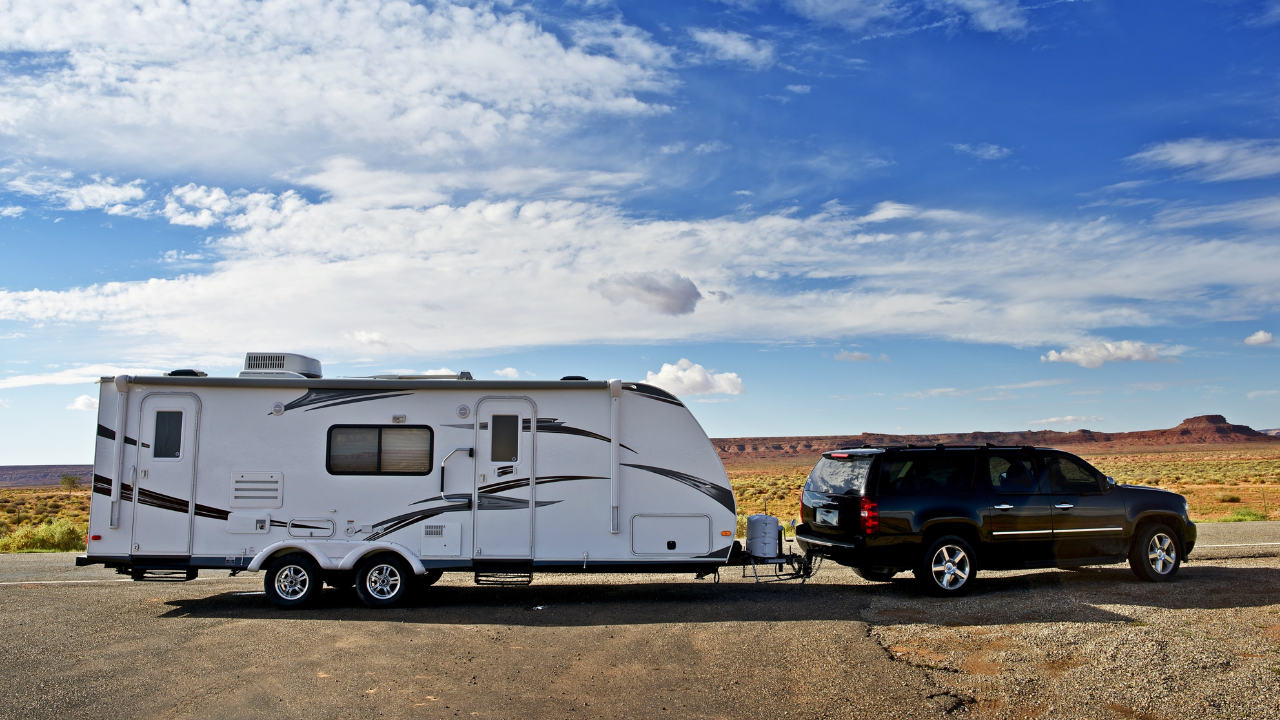
- 1 What is a weight distribution hitch and how does it work?
- 2 Can you back up with a weight distribution hitch?
- 3 Can you back up with weight distribution bars?
- 4 Can you back up with sway control?
- 5 Can you back up with a Reese weight distribution hitch?
- 6 Do you have to remove sway bar when backing up?
- 7 Do you need a sway bar with a weight distribution hitch?
- 8 Can you back up with a husky weight distribution hitch?
- 9 Does a weight distribution hitch take weight off the tongue?
- 10 What happens if weight distribution hitch is too high?
- 11 At what weight should you use a weight distribution hitch?
- 12 Backing up with a Reese Weight Distribution Hitch
- 13 Backing up with a Blue Ox Weight Distribution Hitch
- 14 Backing up with a Curt Weight Distribution Hitch
- 15 Backing up with a Husky Weight Distribution Hitch
- 16 How sharp can you turn with a weight distribution hitch?
- 17 Can a weight distribution hitch damage a trailer?
- 18 Conclusion
Is backing up with a weight distribution hitch really possible? Yes, you can back up with a weight distribution hitch. Many weight distribution hitches, such as Husky and Equalizer, do not need to be removed before backing up, making it easy and convenient to maneuver your vehicle and trailer.
The weight distribution hitch helps distribute the weight of the trailer evenly across the vehicle and trailer axles, improving handling and stability. As a result, you can back up with confidence and enjoy a smoother and safer towing experience.
If you’re planning on towing a trailer, RV camper van, or any other load, having a weight distribution hitch is a must. A weight distribution hitch with sway control helps distribute the weight of the trailer evenly across the vehicle and trailer axles, which eliminates trailer sway, and makes the drive safer and more comfortable.
However, many people have questions about weight distribution hitches, especially when it comes to backing up with them. This article will answer all of your questions and provide a comprehensive guide on how weight distribution hitches work and how to back up with them.
What is a weight distribution hitch and how does it work?
A weight distribution hitch is a device that attaches to the hitch ball of a vehicle and the frame of a trailer. It helps distribute the weight of the trailer evenly across the vehicle and trailer axles, which eliminates trailer sway and improves handling.
The hitch works by applying tension to the spring bars, which transfer the weight of the trailer to the vehicle’s axles. This helps balance the weight, which in turn eliminates trailer sway and improves handling.
Can you back up with a weight distribution hitch?
One of the biggest concerns people have about weight distribution hitches is whether or not they can back up with them. The good news is, yes, you can back up with a weight distribution hitch. It does not impede your ability to reverse or maneuver your vehicle. In fact, weight distribution hitches are designed to improve handling and stability, so backing up with one will be just as easy as backing up without one.
Can you back up with weight distribution bars?
Weight distribution bars are an essential component of weight distribution hitches, and they do not impede your ability to reverse or maneuver your vehicle. You can back up with weight distribution bars just as easily as you would without them.
Can you back up with sway control?
Sway control is a feature found on some weight distribution hitches that helps prevent trailer sway. Like weight distribution bars, sway control does not impede your ability to reverse or maneuver your vehicle. You can back up with sway control just as easily as you would without it.
Can you back up with a Reese weight distribution hitch?
Reese is a well-known brand in the weight distribution hitch industry, and their hitches are known for their high-quality construction and performance. You can back up with a Reese weight distribution hitch without any issues.
Do you have to remove sway bar when backing up?
One of the common questions people have about sway bars is whether or not they have to remove them when backing up. The answer is no, you do not have to remove the sway bar when backing up. The sway bar is designed to be left in place during all driving conditions, including backing up.
Do you need a sway bar with a weight distribution hitch?
While a weight distribution hitch will help eliminate trailer sway on its own, using a sway bar in conjunction with the hitch will further improve handling and stability. It’s not a requirement, but it is highly recommended to use a sway bar with a weight distribution hitch.
Can you back up with a husky weight distribution hitch?
Husky is another well-known brand in the weight distribution hitch industry, and their hitches are known for their high-quality construction and performance. You can back up with a husky weight distribution hitch without any issues.
Does a weight distribution hitch take weight off the tongue?
Yes, a weight distribution hitch helps distribute the weight of the trailer evenly across the vehicle and trailer axles, which reduces the weight on the tongue. By distributing the weight evenly, the hitch helps balance the load, which in turn reduces the weight on the tongue and improves handling and stability.
What happens if weight distribution hitch is too high?
If the weight distribution hitch is too high, it can affect the handling and stability of the vehicle and trailer. It can cause the trailer to be unbalanced, which can lead to trailer sway and other handling issues. To ensure proper weight distribution, it’s important to set the hitch to the correct height and adjust it as needed.
At what weight should you use a weight distribution hitch?
The weight at which you should use a weight distribution hitch varies depending on the type of hitch and the vehicle being used.
However, it’s generally recommended to use a weight distribution hitch when the total weight of the vehicle and trailer exceeds 50% of the vehicle’s weight capacity. It’s important to consult your vehicle’s owner’s manual or a professional to determine the correct weight capacity and when to use a weight distribution hitch.
Backing up with a Reese Weight Distribution Hitch
Backing up with a Reese weight distribution hitch is similar to backing up with other weight distribution hitches. The Reese hitch helps distribute the weight of the trailer evenly across the vehicle and trailer axles, providing improved handling and stability. This allows you to back up with confidence and ease, ensuring a smooth and safe towing experience.
Pros of backing up with a Reese weight distribution hitch:
- Improves handling and stability
- Reduces trailer sway
- Allows for easy and confident backing up
Cons of backing up with a Reese weight distribution hitch:
- The hitch may need to be removed before backing up, depending on the specific model and design.
Backing up with a Blue Ox Weight Distribution Hitch
Backing up with a Blue Ox weight distribution hitch is effortless and straightforward. The Blue Ox hitch helps balance the load of the trailer, reducing trailer sway and improving handling. As a result, you can back up with confidence and enjoy a smooth and secure towing experience.
Pros of backing up with a Blue Ox weight distribution hitch:
- Improves handling
Cons of backing up with a Blue Ox weight distribution hitch:
Backing up with a Curt Weight Distribution Hitch
Backing up with a Curt weight distribution hitch is simple and stress-free. The Curt hitch evenly distributes the weight of the trailer across the vehicle and trailer axles, reducing trailer sway and improving handling. This allows you to back up with ease, ensuring a smooth and safe towing experience.
Pros of backing up with a Curt weight distribution hitch:
Cons of backing up with a Curt weight distribution hitch:
Backing up with a Husky Weight Distribution Hitch
Backing up with a Husky weight distribution hitch is effortless and straightforward. The Husky hitch helps balance the load of the trailer, reducing trailer sway and improving handling. As a result, you can back up with confidence and enjoy a smooth and secure towing experience.
Pros of backing up with a Husky weight distribution hitch:
Cons of backing up with a Husky weight distribution hitch:
- This brand also has other hitch trailer load levelers that may need to be removed before backing up, depending on the specific model and design.
How sharp can you turn with a weight distribution hitch?
With a weight distribution hitch installed, you can make tight turns such as u-turns on the road [1] . However, it is important to be careful when making sharp turns as this may cause the trailer to jackknife [2] .
The amount of tension in the spring bars of the weight distribution hitch will affect how sharp you can turn. Increasing tension will allow for sharper turns, while decreasing tension will limit your turning ability [3] .
In real-world scenarios, a weight distribution hitch should be able to make wide turns around 90-degree corners or higher [4] . However, it is recommended to avoid making sharp turns with a trailer with a weight distribution hitch as this may cause damage to the trailer and vehicle [5] .
Can a weight distribution hitch damage a trailer?
Aweight distribution hitch can not damage a trailer. A weight distribution hitch can add stress to both the trailer and vehicle frame, but this is usually not enough to cause damage [1] . The danger lies in the extra weight added to the trailer axles, which can be too much for some half-ton trucks [2] .
However, most RV trailers are designed to handle the extra weight from a weight distribution hitch [3] . There have been reports of damage or similar issues from using a hitch weight distribution bar or sway bar with a lightweight camper [4] , but overall, a weight distribution hitch is safe when used correctly [5] .
Backing up with a weight distribution hitch is just as easy as backing up without one. It does not impede your ability to reverse or maneuver your vehicle and provides numerous benefits, including improved handling, stability, and reduced trailer sway.
If you’re planning on towing a trailer, RV camper van, or any other load, a weight distribution hitch is a must-have item. By using this comprehensive guide, you can confidently back up with a weight distribution hitch and enjoy a safer and more comfortable towing experience.
Recent Posts
The Magnalite Roaster 4267 VS The Magnalite Roaster 4269 Pot: Which one is better?
When it comes to choosing the perfect roaster pot for your culinary endeavors, the Magnalite roaster 4267 vs Magnalite roaster 4269 are the go-to choices among these classic cookware pots. Sadly,...
What Are Magnalite Pots Made Of? A Deep Dive into Their Unique Composition
Ever wonder what Magnalite pots are made of? Discover the secrets behind the unique composition of Magnalite pots and why Magnalite cookware is still a beloved choice for many cooks in 2023 and...

Home » Towing, Coupling and Docking » Can You Backup with a Weight Distribution Hitch?
Can You Backup with a Weight Distribution Hitch?
RV Expeditioners may collect a share of sales or other compensation from the links on this page. This comes at no additional cost to you, and all the prices and availability are accurate at the time of publishing.
A weight distribution hitch can be handy regardless of the size and weight of the trailer. What’s more, if the gross trailer weight is over 5,000 lbs., you are required to have a weight distribution hitch.
This type of hitch helps to stabilize the trailer and distribute the weight evenly. In turn, this improves handling as you drive.
What about backing up? Can you back up with a weight distribution hitch? The answer to this question depends on the type of WDH. Keep reading to find out what types of weight distribution hitches allow you to back up and how to find the right one for your vehicle and trailer.
What Is a Weight Distribution Hitch?
A weight distribution hitch is one that spreads the trailer tongue’s weight from your car’s bumper to its axles. It is quite a bit more complex than the standard weight carrying hitch and highly recommended if you’re towing a big and heavy trailer.
Generally, it is recommended to go for a weight distribution hitch if the overall weight of the trailer exceeds 50% of your vehicle’s towing capacity, as it makes it both safer AND increases the total weight you can tow.
For example, a trailer that’s far below its maximum weight is unstable and will sway as you drive. Also, it could swing uncontrollably back and forth, potentially causing an accident.
If there’s too much weight on the tongue, the hitch will dive. Your car’s bumper will also dive, which has the effect of lifting the front wheels. This affects steering and braking, representing a constant danger to the passengers and surrounding vehicles.
Recommended read: Benefits of Using a Weight Distribution Hitch
Enter the weight distribution hitch. While it can’t increase your car’s towing capacity, it can transfer some of the trailer’s weight to its rear and front axles, and thus improving handling. Some of the weight might be transferred to the trailer’s axle as well. This will raise the level of safety for you and other vehicles on the road.
Gross Trailer Weight
The gross trailer weight (GTW) is the overall weight of your trailer, whether it is empty or stacked with firewood or hauling jet skis.
For the purpose of determining which weight distribution system to buy, you should only consider your regular GTW. The easiest way to determine that is to weigh your trailer on a public scale. Make sure to disconnect the trailer when it is on the scale to get an accurate reading.
Tongue Weight
The tongue weight is the force that the trailer tongue exerts on the hitch. Ideally, it should be between 9% and 15% of the trailer’s GTW. If it’s below 9%, the trailer might sway and become hard to control. Conversely, if it is above 15% the hitch might sink and compromise your car’s handling.
If you have a small trailer, you can measure the tongue weight with your bathroom scale. For example, your trailer weighs 500 lbs. so you’d want the tongue to weigh around 12% or 60 lbs. Place the trailer’s tongue on the scale and read the weight. If it’s above your target weight, move some cargo back and behind the trailer’s axle. If it’s below the target weight, move some cargo forward and ahead of the axle.
If you have a big trailer, the tongue weight is going to exceed the weight limit of your bathroom scale, but you can buy a tongue weight scale.
The answer is both yes and no; it depends on the hitch. Some models completely prohibit reversing. Some only allow backing up in a straight line but there are others that allow reversing.
If you have a weight distribution system with sway control, then you should avoid reversing as much as possible. If you decide to back up anyway, disengage the sway control and spring bars beforehand.
If your system doesn’t have a sway control system, you shouldn’t have any problems backing up. However, be careful not to make sharp turns as you may jackknife the trailer.
How to Pick a Weight Distribution Hitch
There are various types of weight distribution hitches and you’ll need to select one that’s right for your car and trailer. Also, they differ in terms of weight capacity, so you should take that into consideration. Finally, weight distribution hitches can be expensive. They start at around $200 and up to a grand or so. I've spent a significant amount of time researching the market and here are the top 5 hitches I recommend you invest your money on.
While that article covers the topic in a lot more depth, here’s a quick rundown of what you need to consider when buying a weight distribution hitch.
Overall Weight Capacity
The overall weight capacity of the weight distribution system is perhaps the most important thing to consider when buying a weight distribution hitch. If you pick a system with an overly low weight capacity, you won’t be able to tow your trailer.
On the other hand, going for the biggest and strongest model may not be recommended, either. Some experts say that going 10-15% above your GTW is the best option, while others recommend going up to 50% above.
The main problem with systems that are rated far above your GTW is that they won’t have good shock absorption and they’ll transfer vibration to the trailer. Over time, this might damage both your trailer and your car.
Ball and Shank
Next, you’ll need to pick the right ball and shank that match your weight distribution system. Hitch balls are rated 2,000 to 30,000lbs and you should never go with one that’s rated below your weight distribution system.
You’ll also need to pick the right size. The most common hitch ball sizes are 1-13/16”, 1-7/8”, 2”, and 2-5/16”.
The shanks come in various sizes as well, most commonly ¾”, 1”, and 1-1/4”. If you intend to install a weight distribution system, you’ll have to go with a 1-1/4” shank.
There are two main types of weight distribution hitches – round bar and trunnion. The main difference between the two is in the way they attach to the head.
Alternatively, you can go with the Andersen Weight Distribution Kit. It is a bit more sophisticated. In terms of supported tongue weight, it sits between round and trunnion. Here’s a bit more on each type.
Round bar hitches are generally a bit harder to install, as they require clips to keep them in place. They typically slide up into the head. Furthermore, experts recommend them for lighter loads and smaller trailers. These systems are easy to adjust to the angle of the ball mount.
Round bar systems tend to be slightly more affordable than the trunnion variety. They are recommended for trailers with 600 to 1,200 lbs. tongue weight. Round bar systems are great for flat and well-maintained concrete roads.
As opposed to round bar systems, trunnion hitches are installed from the back or the sides. They are easier to install as they don’t need clips to hold them in place. Most people agree that trunnion systems should be used with bigger and bulkier trailers. Trunnion systems are less prone to ground clearance problems than the round bar variety, making them a better choice for low-clearance trailers.
Trunnion systems are generally a little more expensive and recommended for tongue weights of up to 1,700 lbs. When cornering, trunnion systems lift one bar up and put some extra pressure on your car’s front wheels. This helps handling, especially on macadam and gravel roads.
Andersen Weight Distribution Kit
An Andersen Weight Distribution Kit comes with shock absorbers and chains instead of spring bars. This almost completely eliminates bounce, making for a far smoother ride. The Andersen system includes the trailer ball and friction sway control. It uses a nut to tighten the shocks and chains. The supported tongue weights are between 200 and 1,400 lbs.
Sway Control
Sway control is an important aspect of a weight distribution hitch. Only the most affordable models (designed for the lightest trailers) don’t have sway control. There are four basic types – friction bars, dual cam stabilizers, two-point sway control, and four-point sway control. The quality of the sway control system is reflected in the price.
Friction bars offer basic sway reduction and are best used with compact trailers. You shouldn’t use them with large and heavy trailers.
Dual-cam stabilizers are the next step up. Usually, you’ll see them on smaller setups with lightweight trailers. You may also see them used with flatbed-style trailers.
Two-point sway control is a good option if you have a large trailer that’s longer than 24 feet and has a long overhang behind the rear axle.
Four-point sway control gives the ultimate stability. You should use it if your trailer is over 30 feet long.
Most people would also take the budget into consideration. You can find basic weight distribution systems that are designed for ultra-light trailers for around $200. These models are usually not equipped with sway control or any other fancy features.
At the other end of the spectrum, weight distribution systems with advanced sway control can cost up to $1,000. These are usually heavy duty systems made for the biggest trailers.
Availability
Another thing to consider when buying a weight distribution hitch is availability. Though they’re good to have with compact trailers and mandatory for big ones, they might be hard to obtain. Car dealerships and RV parts stores may not keep them in stock nowadays, or at least not in any variety. You may have to order one online or through a local dealer.
Is it possible to backup with a sway bar?
Friction sway control bars work better going forward than the reverse (backing up straight is fine). However, they are not designed to work when turning backward. Due to the different force that appears to be applied to them when in reverse, it is possible and likely to cause damage to them.
What’s th e Takeaway?
So, can you backup with a weight distribution hitch? Generally yes, though you should be careful.
Backing up with a weight distribution hitch works pretty much the same as backing up with a regular hitch. However, you should always disengage the sway control before backing up.
Sharing is caring!
1 thought on “Can You Backup with a Weight Distribution Hitch?”
I tried one of the new and wonderful WDH when I bought my 39′ Grand Design bumper trailer. That was a mistake, there is no way to keep the torsion bars from slipping out of the hangers on a tight turn, plus I have had people chase me down to tell me that it sounded like I had broken a spring. Never was happy with it.
I still had my Easy-Lift system that I purchased when I bought my 1977 Prowler. I made a ball change and I am currently using it now, now noise, no binding when backing up and the torsion bars side into the bottom of the hitch and are connected to the hangers with chains so they can be adjusted to the trailer weight.
I do have a Sway Control, also from 1977 that works just fine, I do however remove the sway bar when I am baking into a RV slot. I will never go back to the ‘NEW AND WONDERFUL” torsion bar system they have come out with now. Just look at what the design engineers came up with to retro fit a 5 gal gas can!!!!
Just because they are the latest design does not mean they are the best!!
Leave a Comment Cancel reply

The Savvy Campers
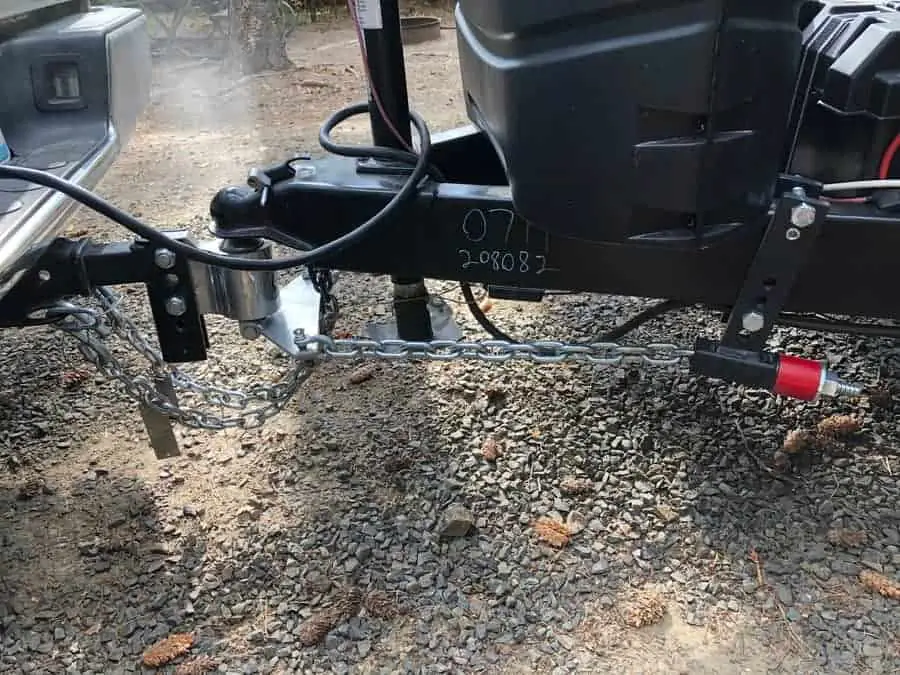
Can You Back Up With a Weight Distribution Hitch Connected?
If you’re new to the world of towing trailers or campers, it’s a surprisingly confusing one. There are many different factors to consider if you’re trying to set your vehicle up for towing purposes. Weight distribution hitches, for example, are quickly becoming the hitch of choice for heavy towing, but there are questions surrounding this type of hitch that make it less than desirable.
Most weight distribution hitches allow backing up in straight lines or making slight turns. Some hitches have no backing restrictions, while most require you to loosen or remove the spring bars and sway control system when making turns while in reverse.
In general, you should always check the specifications of your particular hitch before attempting any backing maneuvers. A big factor determining whether or not you can back up with a weight distribution hitch is the type of hitch you have. In this article, we’ll review some of the different rules for different weight distribution hitches and help you become more prepared for future towing.
What is a Weight Distribution Hitch?
A weight distribution hitch is exactly what it sounds like. It’s a hitch designed to better distribute the weight from the tongue of the trailer or camper you’re towing. It takes a bulk of the weight directly off the bumper of your towing vehicle and distributes it across the front and rear axles. This makes for a smoother towing experience and reduces the amount of stress on your towing vehicle.
A weight distribution hitch makes the connection between the trailer and towing vehicle more level. Rather than having the back of your vehicle buckle and dip under the added weight of the trailer tongue, the weight distribution hitch will keep it level.
Weight distribution hitches usually have bars or chains and use friction to slow down the sway of trailers using friction. This can work at speeds as usually you are not turning very sharp, but when you are backing up, you most likely are making tight turns which can bind your weight distribution hitch and not allow you to remove it.
Can You Back Up When You Have a Weight Distribution Hitch?
Because of how weight distribution hitches are designed and attached to your towing vehicle, they don’t always allow for driving in reverse. Generally, it all comes down to the type of hitch and what the manufacturer specifies about backing up with their weight distribution hitch connected.
Most newer weight distribution hitches allow for backing up and maneuvering. However, you must know what type of hitch you have before attempting to back up because you could damage your hitch, towing vehicle, or trailer.
The Equal-i-zer weight distribution hitch system , for example, allows for full backing up and maneuverability. The system is designed with sway bars and springs that can handle the pivoting action of tight turns in reverse.

However, many weight distribution hitches, such as the Curt Weight Distribution System , don’t have full backing up capabilities. To do anything outside of backing up in a straight or relatively straight line, you’ll have to disconnect the sway bars and friction control system. Attempting to turn at sharp angles and jackknife your truck and trailer won’t be possible with these systems.

Does My Weight Distribution Hitch Allow for Backing Up?
If you currently have a weight distribution hitch installed on your truck or SUV but aren’t sure what its capabilities are, you should check before attempting to back up.
The best way to do this is to find your particular hitch’s brand and model number and look it up online. The manufacturer of your hitch should know whether your model allows for full, partial, or no backing up.
Now when we say you can’t back up, this doesn’t mean you can’t back up at all, it just means you can’t perform sharp turns when in reverse.
How to Safely Back Up With a Weight Distribution Hitch Connected
If your weight distribution hitch has no limitations to backing up, you’re free to drive and maneuver in any way necessary. If your weight distribution hitch has restrictions and limitations to its backing abilities, you’ll first have to disconnect the spring or sway bars and the friction control system. Here’s what you’ll have to do.
- With the ball of the hitch still connected to the trailer, raise the tongue of the trailer to remove tension from on top of the hitch.
- Use your break bar to loosen the saddle of the sway bar where it attaches to the trailer or camper.
- Use the bar to maintain tension as you loosen the bar from the trailer, as it could spring loose and hit something below it.
- Remove the locking mechanism holding the sway bar in place on the trailer.
- Slowly lower the saddle and remove the chain connecting the bar to the trailer.
- Move the bar sideways away from the trailer until it releases from the towing vehicle.
- Repeat these steps on the opposite side so that both bars are loose from the weight distribution hitch.
As you can see, backing up with a restricted weight distribution hitch is more of a hassle than with unrestricted hitches. However, as long as you follow proper procedures for your specific hitch, you can drive your vehicle and trailer in reverse with little issue.
If you don’t want to have to perform all of these steps to back up, we use the Andersen No Sway Hitch and it allows us to back up and fully drive without removing anything from the hitch.

What are the Benefits of a Weight Distribution Hitch?
With all the work and restrictions associated with weight distribution hitches, are they worth the hassle? Here are some top reasons people opt for weight distribution hitches rather than traditional ones.
- It reduces strain and stress on the rear axles of your towing vehicle by distributing weight evenly on all axles
- It ensures that the front axles of your towing vehicle won’t lift off the ground.
- It ensures you’ll have enough braking power to stop your vehicle when necessary.
- It makes for a smoother, more level towing experience
- You’ll have more peace of mind as you’re hauling something down the road
Do I Need a Weight Distribution Hitch?
There’s no question that using a weight distribution hitch can make for a smoother, more enjoyable towing experience. However, weight distribution hitches are costly, take time to install, and aren’t one size fits all. These obstacles have people looking for ways around installing a weight distribution hitch on their towing vehicle.
In general, it’s recommended that if you’re towing anything heavier than 5,000 pounds, you should have a weight distribution hitch. It’s also recommended that you have one of these hitches if your trailer weight is more than one-half of your vehicle’s weight.
Regardless of what you think or what the internet says, however, the best thing you can do is check your owner’s manual for advice. It should specify when you need to add a weight distribution hitch to your towing vehicle based on its weight and the weight of whatever you’re towing.
When buying, make sure you purchase a model with sway control as that is just as important as weight distribution. Once again, our favorite model is the Andersen.
Safe travels!
Be the first to be notified about FREE tips, hints, coupon codes, and email-exclusive information. All for FREE!
Related Posts:
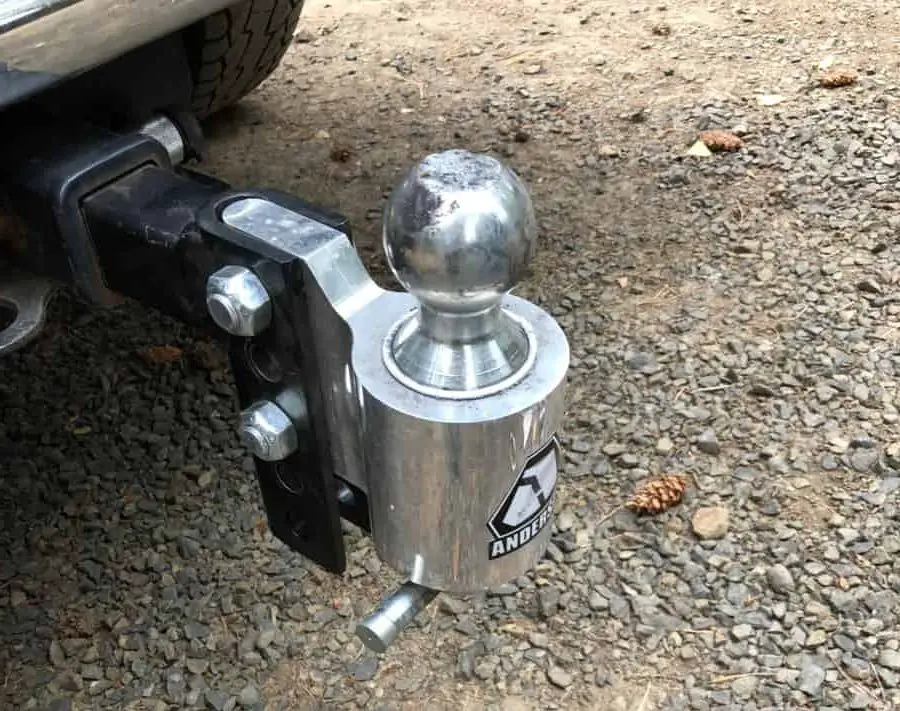
Similar Posts

Why Does My Weight Distribution Hitch Make Noise and How to Quiet It?
Weight distribution hitches (WDH) are meant to make your towing experience easier and more enjoyable. However, depending on your setup and the condition of your hitch, there’s a chance that it can make it more uncomfortable and noisy. Like all types of hitches, weight distribution hitches are prone to squeaking, popping, and creaking noises. If…

Does a Weight Distribution Hitch Reduce Payload on My Tow Vehicle?
Whether you’re a trucker, RVer, or haul trailers as part of your daily job description, things can get dangerous at times. A nifty tool invented to make towing as safe and easy as possible is the weight distribution hitch. While weight distribution hitches have a lot of capabilities, there are certain things it can’t do. …

Does a Weight Distribution Hitch Reduce Sway While Towing?
Whether you’re a first-time tower or a seasoned veteran who does it professionally, trailer sway is a constant fear and problem. No matter how experienced you are in towing trailers or RVs, you can never predict when a stiff breeze will come from out of nowhere. You also can’t predict when you’ll have to swerve…
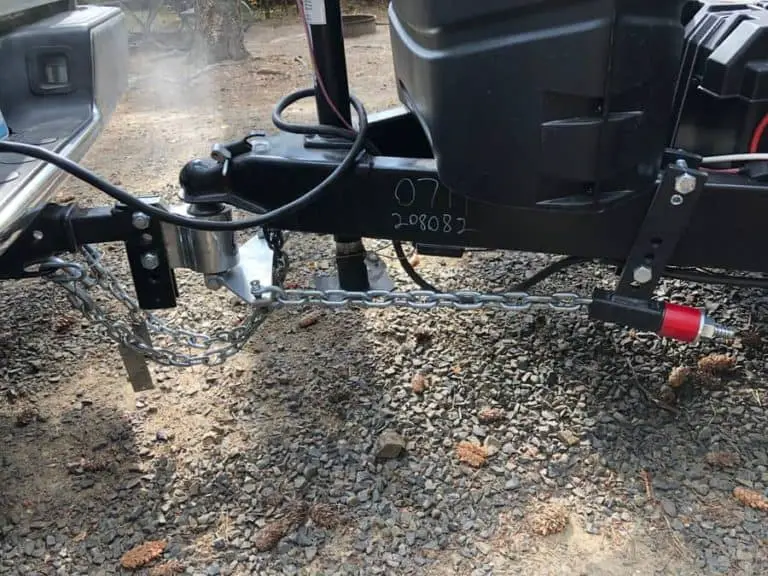
Why a Travel Trailer Weight Distribution Hitch is Essential: Choosing the Right One for Your Needs
Are you a regular traveler who loves touring the world using a travel trailer? If yes, you may recall one nerve-wracking moment when the trailer swayed off the road, and you nearly lost control of the vehicle. Although swinging is a common phenomenon when pulling a heavy load, you can prevent it and avert accidents…
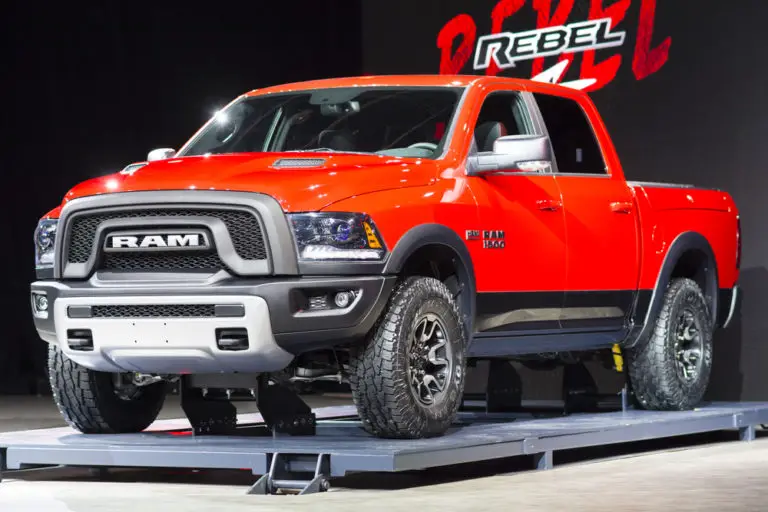
Does a Weight Distribution Hitch Increase Towing Capacity?
Towing a trailer or RV with your truck or car can be a daunting task when you’re not properly prepared. There are tons of horror stories out there about vehicles overturning or going off the road because their trailer swayed or tipped and took them with it. However, with the proper equipment, such as a…

Can You Use a Sway Bar Without Weight Distribution Hitch on your Travel Trailer?
Thanks to tools like sway bars and weight distribution hitches, towing trailers and RVs is safer than ever. However, not everyone wants to invest in both towing tools and would prefer to spend their money on just a sway bar. This begs the question, though, about whether or not it’s ok to use a sway…
Join our Newsletter to stay up to date on the latest RV topics and receive our FREE RV Inspection Cheat Sheet Today. Use this tool to inspect new or used campers you are looking at purchasing.
No thanks, I’m not interested!


- Find a Location
How To Hook Up a Weight Distribution Hitch
A weight distribution hitch is a hitch that connects your tow vehicle to your trailer and more evenly distributes the load across all axles. It disperses the weight across the entire tow vehicle and towable RV setup, making your trailer more easily towable, reducing trailer sway , and other issues that may arise from an imbalance load.
When you hook up your travel trailer or motorhome without a weight distribution hitch, there can be too much weight on the hitch itself which will lead to instability. The same can be said for too much weight on the trailer itself. With too much weight too far back, you’re much more likely to experience trailer sway or fishtailing.
The weight distribution hitch still uses a standard ball hitch, so it’s used with travel trailers and other small towable RVs. It’s an altogether different setup from a fifth-wheel and helps bring stability to the standard towable options.
How Do You Hook Up a Weight Distribution Hitch?

When you purchased your RV, you most likely had the dealership install it on your vehicle. If you didn’t, go back to your local Camping World and have it installed. The initial setup of the hitch is best performed by a specialist.
With the hitch installed, it’s time to discuss the process of actually hitching up your RV with a weight distribution hitch. Let’s dive in.
Read the Instructions
I can’t stress this enough. Read the instructions. Even if you’re reasonably mechanically inclined, the instructions for your hitch will be helpful. Don’t skip this step. You’ll need to read the instructions to know how to adjust your hitch so that it will work with both your RV and your tow vehicle.
Steps in the Process
- Park your RV in a level position with the wheels chocked.
- Distribute the weight evenly inside your RV.
- Set your parking brake on your tow vehicle.
- Measure the height of your RV from the ground to the bottom of the body of the RV. Do this at the front and rear of the RV.
- Measure the height of your tow vehicle from the ground up through the axle to the top of the wheel well (see the video for clarification). Do all four wheels.
- Inspect your hitch bar and ball mount assembly.
- Insert the shank into the rear receiver tube on your tow vehicle.
- Insert the hitch pin and secure it with the clip.
- Grease the hitch ball.
- Raise the tongue of the trailer higher than the hitch ball.
- Release the parking brake and back the tow vehicle up so that the hitch ball is directly under the coupler. Set the parking brake again.
- Lower the trailer coupler onto the hitch ball. Latch the coupler and insert the latch pin.
- Raise the trailer tongue and rear of the tow vehicle to remove weight from the hitch.
- Inspect the spring bars, lift chain links, and snap-up brackets.
- Grease the spring bar attachment points.
- Insert the spring bar into the hitch head assembly. Put the bottom knob in and rotate it into place so the top knob moves into place. Then swing the spring bars into a position parallel with the frame.
- Position the snap-up bracket yolk parallel to the ground. Slip the yolk chainlink over the hook and make sure the lift chain is not twisted. (There should be a minimum of five chain links between the hook and the spring bar.) Secure the yolk with a locking container pin.
- Do the last three steps again on the other side.
- Lower the trailer tongue so the weight rests on the hitch.
- Hook up your safety chains by crisscrossing them under the coupler.
- Connect the breakaway electrical cable to your tow vehicle and check the trailer’s lights.
- Do a final check of all hitch pins, brackets, chains, etc.
- Double-check the jacks and stabilizers are up, and then remove the wheel chocks.
You did it! To ensure you completed the process properly, you should remeasure the trailer and tow vehicle at the exact same points you did in steps 4 and 5. These measurements will be different than when you first started. You’ll need to determine the difference between those numbers and then refer to the weight distribution hitches manual to ensure you’re within the recommended specifications.
If you’re not within the recommended specifications, then you should either head to your local Camping World or Good Sam members can reach out to the Elite Service Tech Advisor line for help.
- Comment (2)
My spring bar on the driver’s side comes out of the hitch insertion cup when the chain is hooked up to the RV tongue. We learned the hard way, that when we travel the bar drops down onto the road and drags on the pavement. We stopped that from happening by tying a rope around the spring bar and the RV tongue. What needs to be done to stop this from happening?
Hey Gary, sounds like an issue with the hitch adjustment or possibly the hitch itself. If you have time, it could be worth it to take it into a service center to have it checked out.
Leave Your Comment Cancel Reply
Save my name, email, and website in this browser for the next time I comment.
Shop By RV Type

Your Adventure Awaits
Copyright © 2023 cwi, llc all rights reserved.
- RV Glossary |
- Privacy Policy |
- California Privacy Rights |
- Do Not Sell or Share My Personal Information |
- Targeted Advertising Opt Out |
- Terms of Use
JavaScript seems to be disabled in your browser. For the best experience on our site, be sure to turn on Javascript in your browser.
- My Purchase Orders
- Compare Products

Weight Distribution Hitch Setup
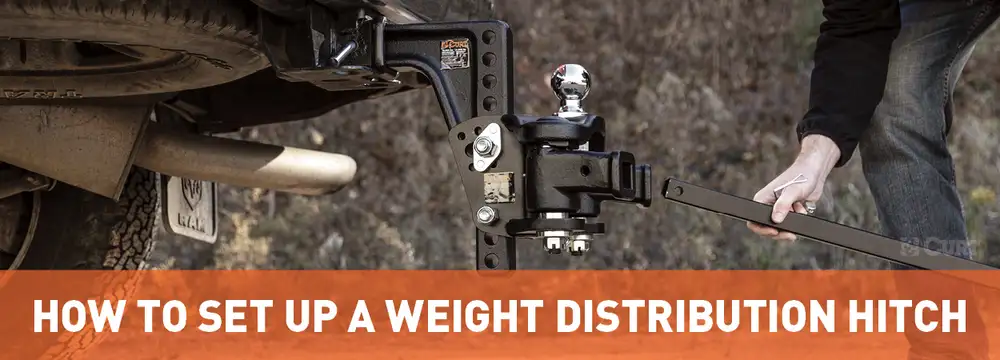
8 Easy-to-Follow Steps!
Weight distribution hitch installation involves leveling the trailer, measuring vehicle and trailer height, mounting the hitch head, shank, spring bars and hookup brackets, and adjusting the weight distribution hitch as needed.
In this guide, we will cover step by step how to set up a weight distribution hitch. Each hitch is unique, so make sure you follow the instructions included with your particular model.
Weight Distribution Hitch Installation Video
How to Install and Adjust Your Weight Distribution Hitch
Step 1: measure vehicle and trailer height.
Park your vehicle and trailer on a level surface and use the trailer tongue jack and a level to make sure your trailer is parallel with the ground.
Measure and record the height of your vehicle and trailer. You will need to know the distance from the ground to the top of the trailer coupler and the distances from the ground to the bottom of the rear bumper and front bumper on your tow vehicle. You can also use the distance from the ground to wheel well if you prefer.
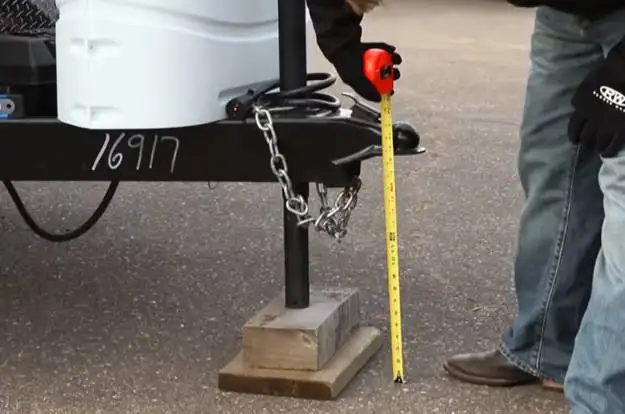
Step 2: Attach the WD shank and hitch head
Insert the weight distribution shank into the receiver tube. Be sure that the shank is fully inserted in the receiver tube of your trailer hitch and secure it using a hitch pin & clip.
Position the head assembly on the adjustable shank. The head should be raised into position so that the top of the trailer ball is one to three inches above the coupler height. Use one mounting bolt at the bottom of the assembly to hold it in place, but do not tighten with a nut.
Need more drop or rise? Shop replacement shanks
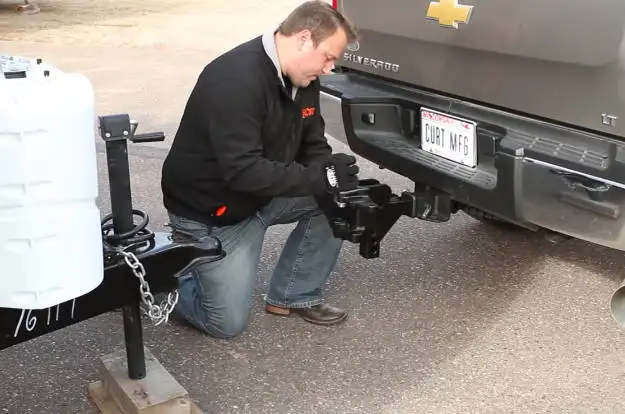
Step 3: Set weight distribution hitch head angle
Pivoting the head downward, place two washers on the adjustment rod and insert the rod into the lower hole on the head. Some weight distribution hitches may not require this step, having a different adjustment mechanism. Remember to consult the instructions specific to your weight distribution hitch.
Rotate the head up into the mounting position on the shank. It should be vertical or tilted slightly back. You may need to add or remove washers to achieve the proper angle.
Finally, insert the second bolt into the top hole in the hitch head and fasten both bolts with the provided nuts and washers. Tighten the bolts but only enough to hold the head in place.
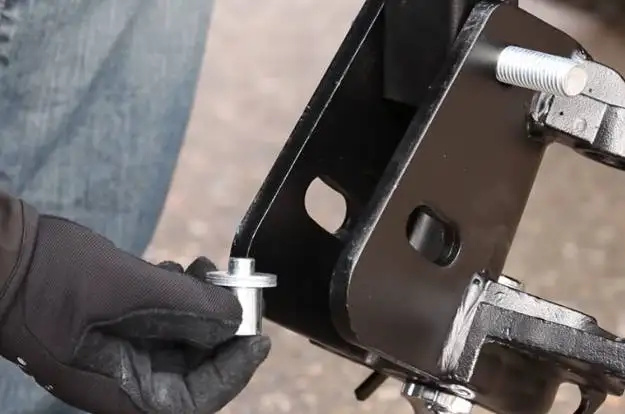
Step 4: Install spring bars and couple the trailer
Mount the spring bars on the hitch head. If the spring bar chains have not yet been attached, attach them to the spring bars before mounting the bars to the head.
Raise the trailer coupler, and back the tow vehicle up to couple the trailer to the trailer ball.
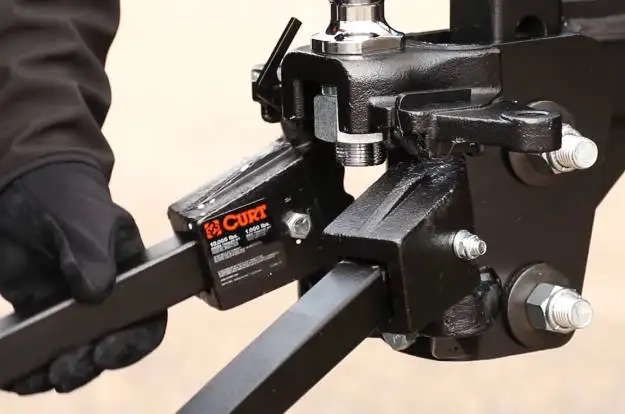
Step 5: Raise the trailer jack
With the coupler latched onto the trailer ball, lift up the coupling point using the trailer jack. The coupler should be raised about three inches above the level position.
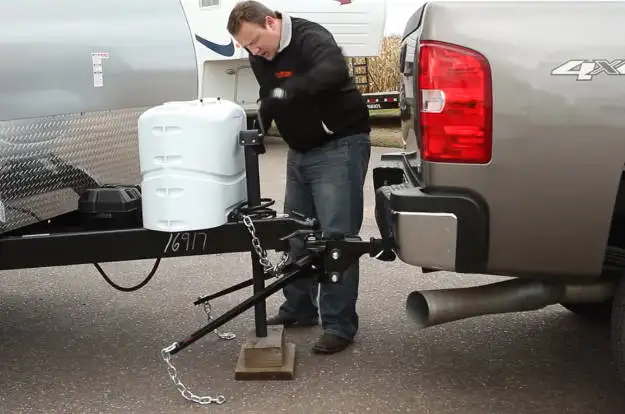
Step 6: Engage the hookup brackets
Position the spring bar hookup brackets on the trailer frame using the spring bar chains as a guide. Mount the brackets onto the trailer frame using the provided bolts.
Then, attach the spring bar chains to the brackets. Make sure both sides are spaced the same vertically, with number of chain links between the spring bars and the hookup brackets. Then pry the brackets into the locked position using the provided lift handle.
Note: There must be a minimum of five chain links between the bracket and the spring bar.
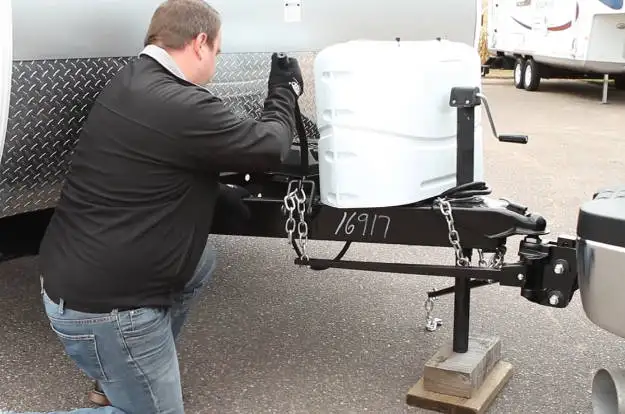
Step 7: How to adjust weight distribution hitch
Retract the trailer jack so that the full weight of the trailer is resting on the hitch. Then, re-measure the distances between the ground and the front and rear bumpers. Each distance should be within 1/2" of the original measurement. If the distances have changed too drastically, you can adjust the number of links on the spring bar chains to increase or decrease tension. You can also adjust the tilt of the head unit.
Step 8: Fully tighten the bolts
Uncouple the trailer and torque all hardware to the values specified in the instructions.
Weight distribution setup differs across various models. With your weight distribution hitch, always follow the instructions provided by the manufacturer, and remember to take your time.
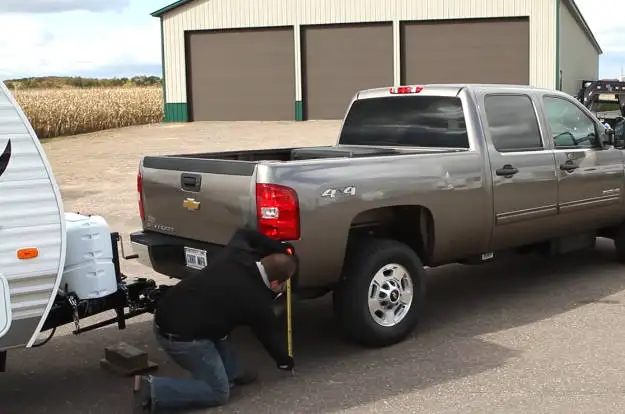
Weight distribution and sway control in one product!
The TruTrack™ weight distribution hitch features an innovative design that levels the vehicle-trailer combination, while actively keeping the trailer from swaying.
No need for a separate sway control unit!

How to Choose and Install the Right Weight Distribution System
Travel trailers offer an incredible sense of freedom and adventure, but they also require careful attention to safety and performance. One critical aspect of towing a travel trailer is ensuring proper weight distribution. In this guide, we’ll explore everything you need to know about choosing and installing the right weight distribution system for your travel trailer.
Table of Contents
Understanding the Importance of Weight Distribution Systems for Travel Trailer Safety
Weight distribution systems play a crucial role in travel trailer safety by evenly distributing the trailer’s tongue weight across the tow vehicle and trailer axles. This helps to:
- Improve steering and handling
- Enhance braking performance
- Minimize trailer sway
- Maintain even tire wear
Using a weight distribution hitch can significantly improve your towing experience and help prevent dangerous situations on the road.
Types of Weight Distribution Hitches: Trunnion Bars vs. Round Bars
Weight distribution hitches come in two main types: trunnion bars and round bars. Both types use spring bars to distribute weight, but they differ in design and functionality:
- Trunnion bars have a square profile and attach directly to the hitch head, offering greater ground clearance and increased weight capacity.
- Round bars have a round profile and attach to the hitch head using chains, providing a smoother ride and easier installation.
Consider your specific towing needs and preferences when choosing between trunnion bars and round bars.
How to Calculate the Required Weight Distribution Hitch Capacity for Your Travel Trailer
To determine the right weight distribution hitch capacity for your travel trailer, you’ll need to know the Gross Trailer Weight (GTW) and Tongue Weight (TW) . The GTW is the total weight of your loaded trailer, while the TW is the amount of weight pressing down on the hitch. As a general rule, the hitch capacity should be greater than the GTW and within the range of the TW.
Choosing the Right Weight Distribution Hitch Based on Your Travel Trailer’s Tongue Weight
Selecting a weight distribution hitch based on your trailer’s tongue weight is essential for optimal performance and safety. To find the right hitch, follow these steps:
- Determine your travel trailer’s tongue weight.
- Consult the hitch manufacturer’s guidelines for weight capacity.
- Choose a hitch that falls within the range of your trailer’s tongue weight.
Tips for Selecting a Weight Distribution System Compatible with Your Tow Vehicle
To ensure compatibility between your tow vehicle and weight distribution system, consider:
- Your tow vehicle’s towing capacity
- The receiver hitch size on your tow vehicle
- The hitch ball size required by your travel trailer
- The drop or rise needed to keep the travel trailer level
Always consult your tow vehicle’s owner’s manual and the hitch manufacturer’s recommendations to ensure compatibility.
The Benefits of Integrated Sway Control in Weight Distribution Systems
Integrated sway control can help to further minimize trailer sway and improve towing stability. There are two main types of sway control:
- Friction sway control uses friction to resist trailer sway, which can be adjusted to suit your towing needs.
- Dual-cam sway control uses cams to keep the trailer centered and reduce sway.
Consider a weight distribution system with integrated sway control for enhanced safety and performance.

How to Properly Measure Your Travel Trailer and Tow Vehicle for Weight Distribution Hitch Installation
Before installing a weight distribution hitch, measure your travel trailer and tow vehicle to ensure proper fit and adjustment. Key measurements include:
- Hitch ball height : Measure the distance from the ground to the top of the hitch ball on both the tow vehicle and travel trailer.
- Coupler height : Measure the distance from the ground to the bottom of the trailer coupler.
- **Drop or rise**: Determine the difference between the hitch ball height and the coupler height. This value will help you select the appropriate shank for your hitch.
Follow these steps to install a weight distribution hitch on your travel trailer:
- Park your tow vehicle and travel trailer on a level surface, and engage the parking brakes.
- Assemble the hitch head, shank, and hitch ball according to the manufacturer’s instructions.
- Attach the assembled hitch to your tow vehicle’s receiver and secure it with the appropriate hitch pin.
- Measure and adjust the hitch ball height to match the trailer coupler height.
- Connect the trailer coupler to the hitch ball and secure the coupler latch.
- Install the spring bars and brackets according to the hitch type (trunnion bars or round bars).
- Adjust the spring bar tension as per the manufacturer’s recommendations.
- Connect any additional sway control devices, if applicable.
Adjusting the Weight Distribution Hitch for Optimal Performance and Safety
Once your weight distribution hitch is installed, it’s essential to fine-tune the adjustments for optimal performance and safety. Key adjustments include:
- Spring bar tension : Adjust the tension to distribute the trailer’s tongue weight evenly across the tow vehicle and trailer axles.
- Sway control : If using a friction sway control device, adjust the friction to match your towing conditions.
- Hitch ball height : Recheck and adjust the hitch ball height as needed to ensure the travel trailer remains level.
The Role of Shank Length and Rise in Weight Distribution Hitch Selection
The shank length and rise play an essential role in ensuring proper hitch ball height and trailer leveling. The shank length determines the distance between the hitch head and the tow vehicle’s receiver, while the rise is the vertical distance required to match the hitch ball height to the trailer coupler height. Select a shank with the appropriate length and rise for your specific towing setup.
How to Choose and Install the Right Hitch Ball for Your Weight Distribution System
Choosing the right hitch ball is crucial for a secure connection between your travel trailer and tow vehicle. Consider the following when selecting a hitch ball:
- Ball size : Ensure the hitch ball size matches your trailer coupler.
- Shank diameter : Choose a hitch ball with a shank diameter compatible with your weight distribution hitch.
- Weight capacity : Select a hitch ball with a weight capacity greater than your trailer’s Gross Trailer Weight.
To install the hitch ball:
- Insert the hitch ball shank into the hitch head.
- Secure the hitch ball with a washer and nut, tightening it to the manufacturer’s torque specifications.
- Use a torque wrench to ensure proper tightening.
Troubleshooting Common Weight Distribution Hitch Issues and Solutions
Common weight distribution hitch issues include:
- Trailer sway : Check and adjust spring bar tension and sway control settings as needed.
- Uneven weight distribution : Reevaluate your travel trailer’s loading and adjust the spring bar tension.
- Hitch noise : Lubricate the hitch ball, spring bars, and other moving parts to minimize noise.
The Impact of Weight Distribution Systems on Tow Vehicle Handling and Stability
Properly installed weight distribution systems can significantly improve tow vehicle handling and stability by:
- Distributing weight evenly across the tow vehicle and trailer axles
- Reducing trailer sway
- Improving steering and braking performance
Always adjust your driving habits to account for the added weight and size of your travel trailer.
Proper Maintenance and Care for Your Weight Distribution Hitch System
Regular maintenance and care for your weight distribution hitch system will prolong its lifespan and ensure optimal performance. This includes:
- Inspecting the hitch components for wear
- Lubricating moving parts, such as the hitch ball, spring bars, and sway control devices
- Checking and tightening bolts and connections as needed
- Cleaning and protecting the hitch from corrosion and rust
- Storing the hitch in a dry and protected area when not in use
How to Safely Disconnect Your Weight Distribution Hitch When Not in Use
To safely disconnect your weight distribution hitch:
- Park your tow vehicle and travel trailer on a level surface and engage the parking brakes.
- Lower the trailer’s tongue jack to take the weight off the hitch ball.
- Release any tension on the spring bars, and remove them from the hitch head and brackets.
- Disconnect any sway control devices.
- Release the trailer coupler latch and raise the tongue jack to separate the trailer from the hitch ball.
- Remove the hitch from your tow vehicle’s receiver and store it properly.
Choosing Between Fixed and Adjustable Weight Distribution Systems
Fixed weight distribution systems have a set hitch head angle and shank drop/rise, while adjustable systems allow for customization to suit various towing setups. Adjustable systems offer greater flexibility, especially if you tow different trailers or change your tow vehicle, but they may be more expensive than fixed systems.
Upgrading Your Travel Trailer Suspension to Complement Your Weight Distribution Hitch
Upgrading your travel trailer suspension can enhance the performance of your weight distribution hitch and improve overall towing stability. Suspension upgrades include:
- Shock absorbers : Improve ride quality and reduce bouncing.
- Air springs : Enhance load leveling and support.
- Equalizer systems : Further distribute weight across the trailer axles.
Consult with a professional or your travel trailer manufacturer for recommendations on suspension upgrades.
The Role of Air Bags and Helper Springs in Improving Weight Distribution
Air bags and helper springs can be added to your tow vehicle’s suspension to enhance weight distribution, stability, and ride comfort. These components work by providing additional support to the tow vehicle’s suspension, helping to level the vehicle and maintain proper alignment when towing a heavy trailer.
Understanding the Limitations of Weight Distribution Systems and When Not to Use Them
Weight distribution systems have limitations and may not be suitable for all towing situations:
- Towing capacity : A weight distribution hitch does not increase your tow vehicle’s towing capacity.
- Surge brakes : Some travel trailers with surge brakes may not be compatible with certain weight distribution systems due to potential interference with the braking mechanism.
- Tow vehicle compatibility : Some vehicles, such as those with unibody construction or specific suspension types, may not be compatible with weight distribution hitches.
Always consult your tow vehicle’s owner’s manual and the hitch manufacturer’s guidelines to ensure the proper use of a weight distribution system.
Comparing Popular Weight Distribution Hitch Brands and Models
There are several popular weight distribution hitch brands and models on the market. When comparing options, consider factors such as:
- Weight capacity
- Hitch type (trunnion bars vs. round bars)
- Integrated sway control
- Ease of installation and adjustment
- Price and warranty
Some well-known weight distribution hitch brands include:
- Equal-i-zer
Take the time to research and compare different models to find the best weight distribution system for your travel trailer and towing needs.
Good luck, and happy camping!
Check out our article on: Best Weight Distribution Hitch For (Safe Proper Towing)
Please keep in mind that we may receive commissions when you click our links and make purchases. However, this does not impact our reviews and comparisons. We try our best to keep things fair and balanced, in order to help you make the best choice for you.
As an Amazon Associate, I earn from qualifying purchases.

How To Back Up a Trailer
Jackknives are cool in the pool, not when pulling trailers.
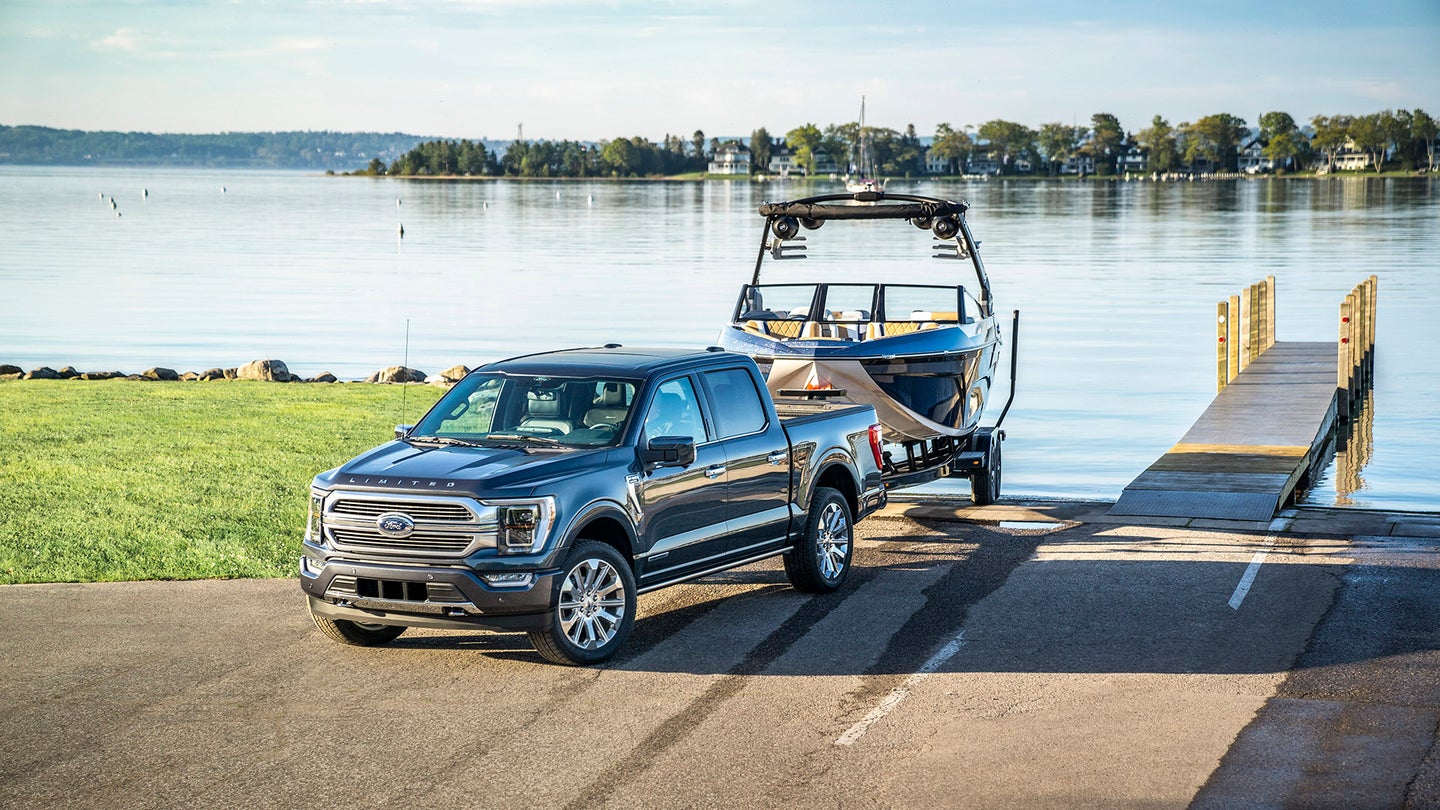
We may earn revenue from the products available on this page and participate in affiliate programs. Learn more ›
The Drive and its partners may earn a commission if you purchase a product through one of our links. Read more.
So you want to back up a trailer? Whether that be taking the jet ski to the lake or snaking a trailer full of paver bricks to the backyard for landscaping, you’re gearing up for an adventure that’ll put your driving skills to the test.
The know-how needed to back up a trailer uses the same simple techniques despite vehicle size, steering ratios, and the size of the trailer. Ultimately, the goal is to prevent hitting anything with the trailer or the vehicle and to avoid jackknifing , when the trailer and vehicle end up in a v-shaped position that could result in damage. That said, the task at hand will also present different challenges based on the space and surroundings.
Regardless of the mission, having the dexterity to place a trailer while in reverse is useful knowledge that can be tackled with a little guidance and a pocket full of patience. To aid in getting you backing up a trailer like a pro, The Drive ’s crack How-To team is here to help. Ready?
Backup a Trailer Basics
Estimated Time Needed: Less than a half-hour
Skill Level: Beginner-Intermediate
Vehicle System: Dynamics
What Is Backing Up a Trailer?
Although a trailer will be pulled forward for 90 percent of its life, it’s the 10 percent when it’s pushed back that causes issues and frustration for inexperienced towers. This skill becomes valuable when launching a watercraft, stowing something away in a barn or garage, delivering supplies for a house remodel, or placing a pop-up camper at a state park. Even when you pull forward into a driveway, somebody’s gotta back it out!
Trailers operate somewhat counterintuitively as turning the steering wheel left will push the trailer right. Turning the wheel right will kick the truck’s rear end right and push the trailer left. Essentially, the direction the wheel is turned will be the opposite of the direction the trailer will go.
One major factor in backing up a trailer is speed. Take it slow. The quicker you drive, the quicker something can go wrong, and you’ll have to correct it by starting over.
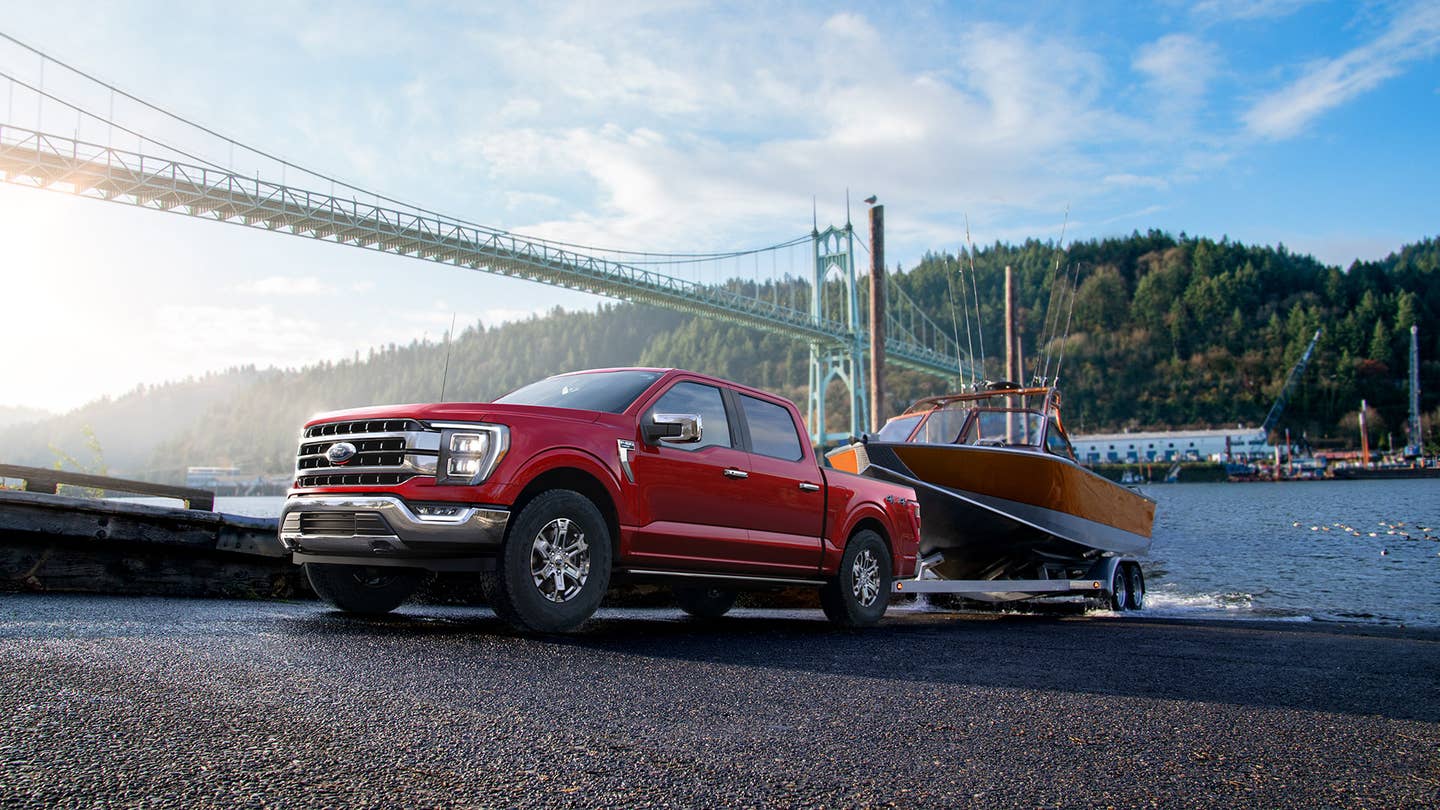
What Are Some Common Trailer Hitch Variants?
A trailer’s hitch is where it and the vehicle towing it couple together and commonly features a ball-in-socket design, along with chains and an adapter for brake and indicator lights. However, there is a variety of hitches available. Here’s a rundown of the most common trailer hitches.
- Weight-carrying : The most common hitch that does not feature add-on accessories for a weight-distribution system. Thus, the weight is loaded on the hitch.
- Weight-distributing : Using add-ons such as a spring bar, a weight-distributing hitch system distributes trailer tongue loads to the vehicle’s front axle and the trailer axle(s).
- Fixed Tongue : Features with a permanent ball that cannot be removed.
- Receiver : Features a hollow square tube where a variety of tongues or inserts, such as a bike rack, can be attached.
- Gooseneck : A ball at the center of a truck bed is paired with a coupling on the trailer.
- Fifth-Wheel : These hitches are typically used for heavier recreational vehicles. Similar to a gooseneck, it uses an attachment in a truck bed, but instead of a ball, there is a C- or U-shaped coupling that is mounted to the bed on a large plate. The trailer connects with a large pin and a plate of its own.
- Pintle : This type of hitch pairs what is known as a pintle hook to a lunette eye. Basically, a hook connects to a circle. Typically used for heavy-duty commercial, military or farming settings.
What Are the Trailer Hitch Classes?
Overstressing any component involved in towing, whether that’s the vehicle, the trailer or the hitch, could be disastrous, so it’s important to know the differences between hitch classes.
- Class 1 : Also known as Light Duty, Class 1 hitches can handle Up to 2,000 pounds gross trailer weight and up to 200 pounds tongue weight. These are typically found on cars and crossovers and feature 1.25-inch receivers.
- Class 2 : Also known as Regular Duty, Class 2 hitches can handle up to 3,500 pounds gross trailer weight and up to 350 pounds tongue weight. These are typically found on cars, crossovers, and minivans and feature 1.25-inch receivers.
- Class 3 : Also known as Heavy Duty, Class 3 hitches can handle up to 8,000 pounds gross trailer weight and up to 800 pounds tongue weight. These are typically found on crossovers, minivans, SUVs, and light trucks and feature 2-inch receivers.
- Class 4 : Also known as Super Duty, Class 4 hitches can handle up to 10,000 pounds gross trailer weight and up to 1,000 pounds tongue weight. These are typically found on trucks and SUVs and feature 2-inch receivers.
- Class 5 : Also known as Extra Duty, Class 5 hitches can handle between 16,000-17,000 pounds gross trailer weight and up to 2,550 pounds tongue weight. These are typically found on trucks and SUVs and feature 2-inch receivers.
- Class 5 : Also known as Commercial Duty, Class 5 hitches can handle between 18,000-20,000 pounds gross trailer weight and up to 2,700 pounds tongue weight. These are typically found on dually and chassis cab trucks and feature 2.5-inch receivers.
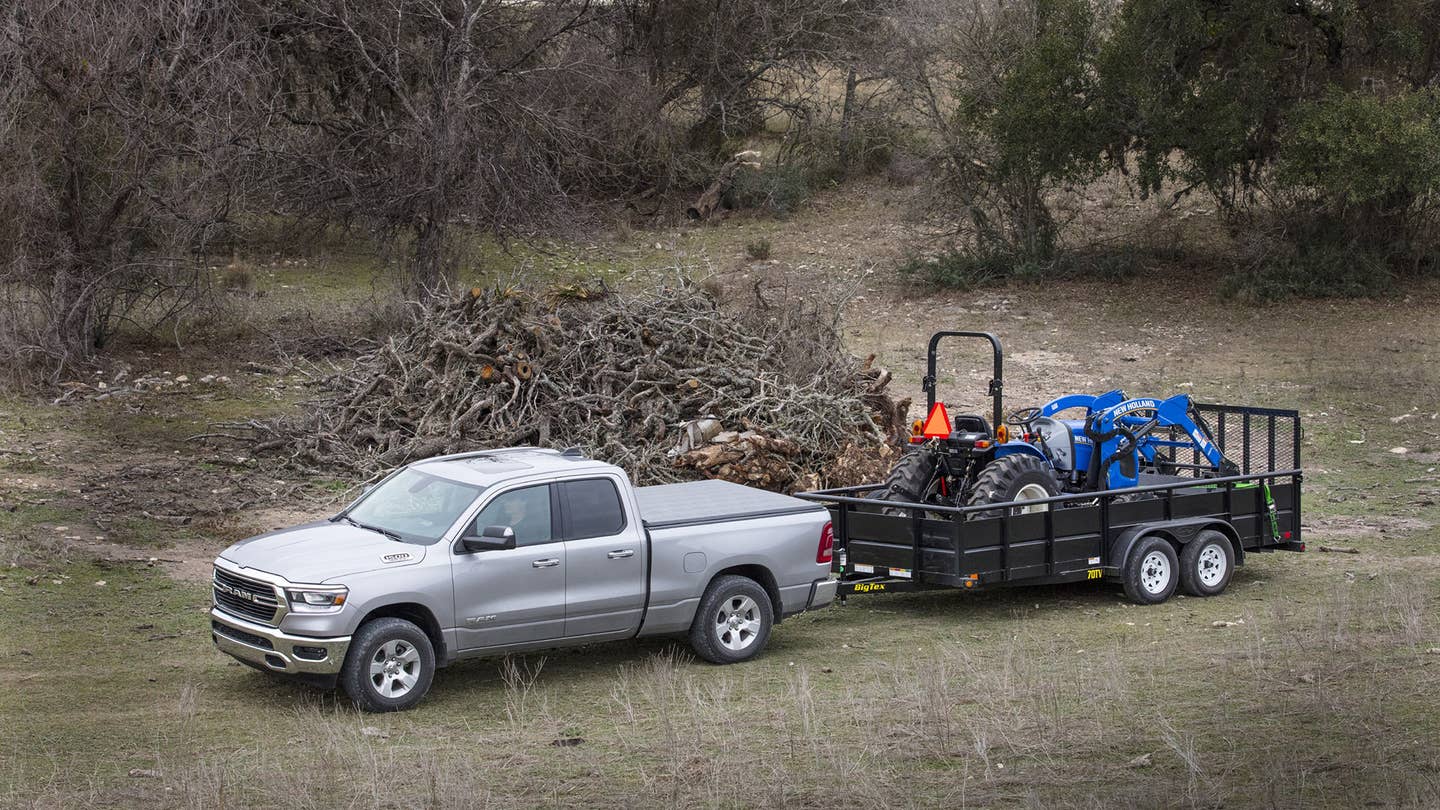
Trailer Backup Safety
Backing up a trailer could quickly go south, so preparation is paramount. Here’s what you’ll need to do to ensure you don’t destroy property, injure yourself and others or crumple your trailer and vehicle.
- Check your tires for adequate air pressure for proper towing capability, stability and traction.
- Check the security of the pin connector that links the truck to the trailer's brake and indicator lights and double-check that they function properly.
- Balance between a vehicle and its trailer is crucial. If the vehicle is squatting, meaning the rear is lower than the front, there’s a chance the trailer is too heavy near the trailer’s tongue. If the rear of the vehicle is lifting, the trailer is likely too heavy near the rear.
- The primary connection between the vehicle and the trailer is the hitch ball and coupling. Check to make sure the hitch ball is the proper size for the coupling and double-check that the coupling is locked in place.
- Make sure the pin or a padlock on the coupling latch adds the final layer of protection from disconnection.
- Large-link, cross-linked safety chains act as the last wall of defense and resemble an “X” when set correctly.
- Angle the vehicle’s side-view mirrors so that the vehicle, the trailer, the destination and the surroundings are all in view.
- Keep the windows down. You never know when somebody shouting to stop will save you thousands of dollars.
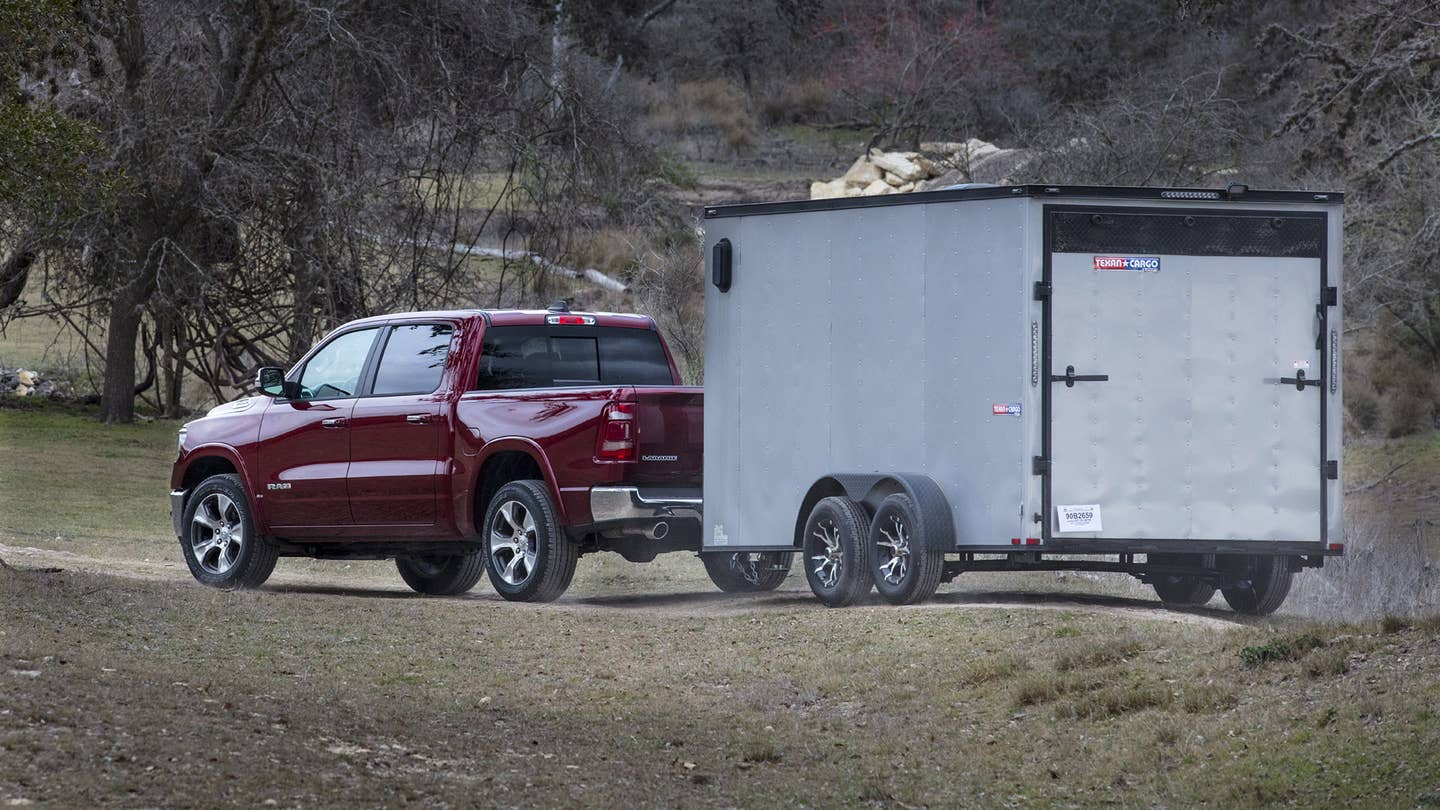
Organizing your tools and gear so everything is easily reachable will save precious minutes waiting for your handy-dandy child or four-legged helper to bring you the sandpaper or blowtorch. ( You still won't need a blowtorch for this job. Please don’t have your kid hand you a blowtorch—Ed. )
You’ll also need a wide, flat piece of pavement, such as a parking lot or nice quiet street. A parking lot is a great place to start, as there is more open area and the parking spaces can be used as guidelines. Once comfortable in a lot, try backing up into your driveway. This will allow you to practice backing into a spot at a 90-degree angle.
Everything You’ll Need To Backup a Trailer
If you have a stylish speckled-floor garage that has wrenches, hammers, saws, nuts, and bolts neatly organized in black and red Craftsmen chests, nice work. That’s beautiful, but you won’t need any of it, save for a couple things. The items below will prove useful in preparing for towing, forward or reverse.
- Trailer Hitch
- A truck or SUV
- Tire pressure gauge
- Mirror extensions (optional)
- Sunglasses (optional)
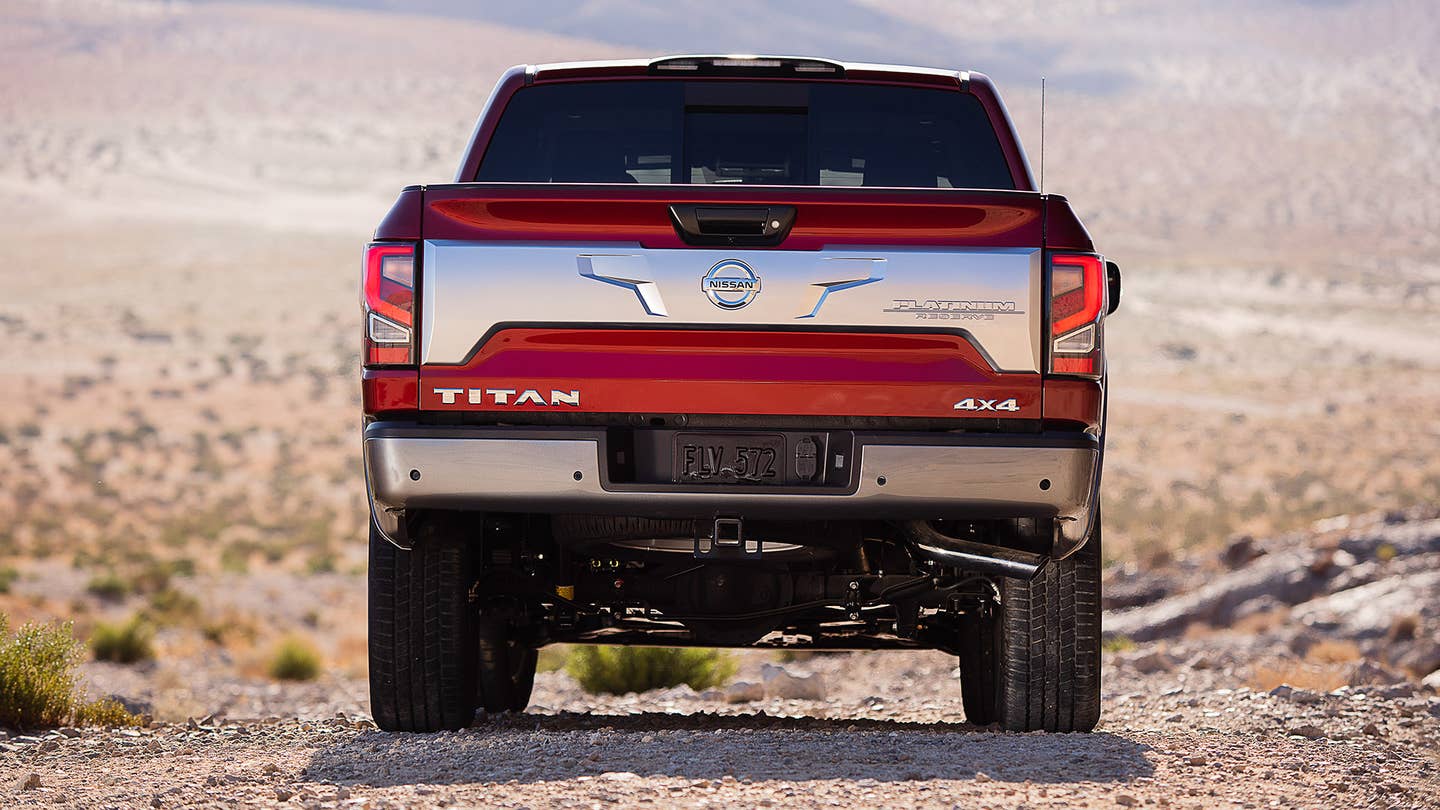
Here’s How To Backup a Trailer
Let’s do this!
- Check the trailer’s hitch, chains, and brake and indicator lights.
- Get into your vehicle, put your foot on the brake, start the car, and move the shifter into reverse.
- Check your surroundings.
- Try to line up as straight as possible, with the desired destination aligned with the outside edges of the vehicle and trailer.
- Be aware of obstacles and try not to fixate on them as you’re sure to do exactly what you didn’t want to do; hit them.
- With a foot on the brake, slowly release to allow the idle to begin reversing the vehicle.
- Use the side mirrors to maintain your view of the intended destination. (In some cases, the driver will need to look over his or her shoulder.)
- Countersteer when necessary and continue to reverse until the trailer is in the desired position.
- Hit the brakes and shift the vehicle into park.
- If this is the final position, turn the car off and you’re set. If this is a drop-off, release the cargo and pull away.
You did it, congratulations!
It’s important to understand that there is a point where the backup is a failed mission and will need to be reset. If you notice your steering is a Mortal Kombat combo of left-right-left-right-left-right, it might be worth driving forward, returning to the starting point and trying again (there’s no shame in that!). The goal is to steer the trailer with a few smooth, continuous inputs.
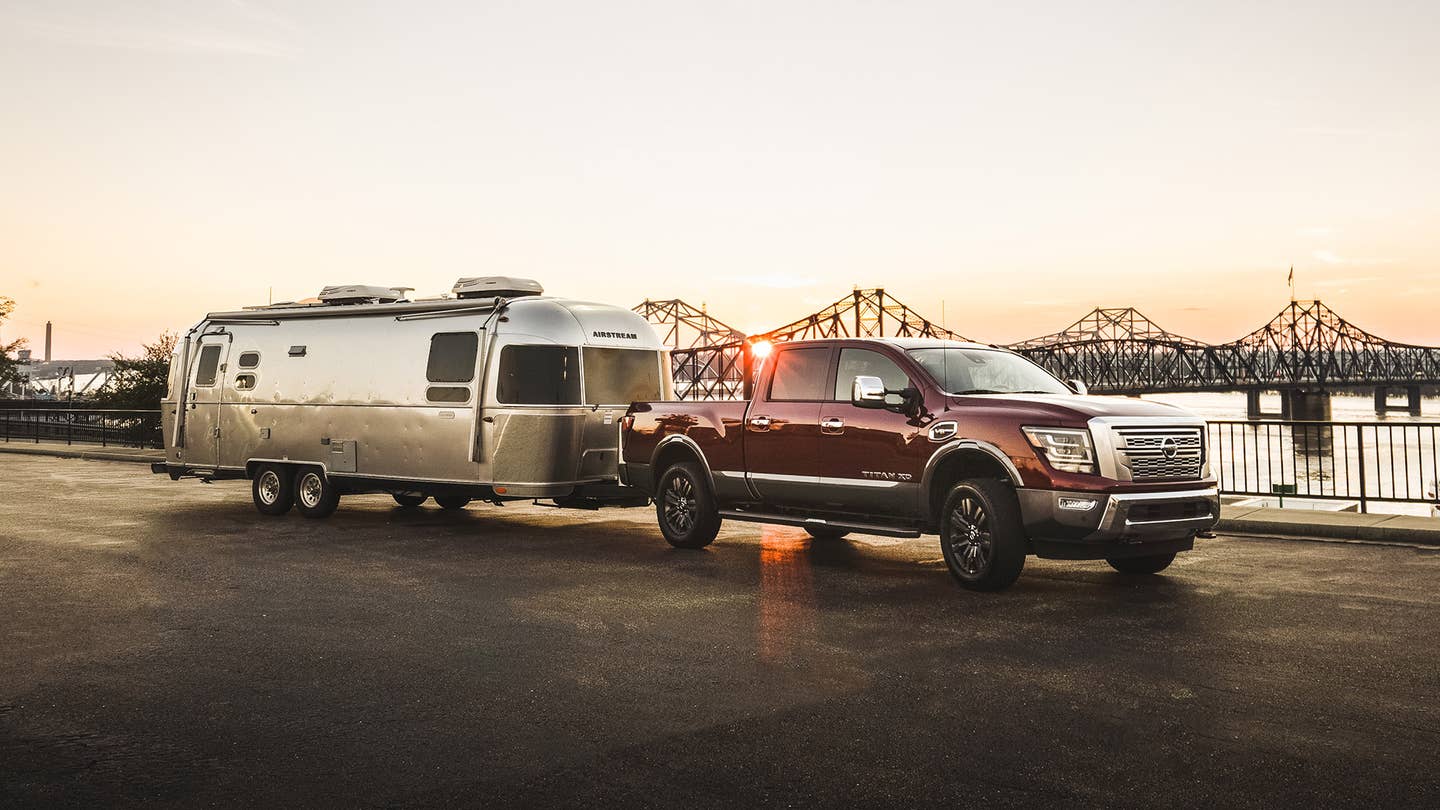
Pro Tips to Backup a Trailer
Here are The Drive’s pro tips for how to backup a trailer.
- Shift your hand position to the bottom of the steering wheel. With your grip on the lower part of the wheel, moving your hands left will result in the trailer angling left because the wheel is turning right. Move your hands right, and the trailer will angle right because the wheel is turning left. This might be more difficult for some, but many might find the direct correlation of movement to be helpful.
- Use a spotter! No matter the experience level, safety nets are tremendously helpful. There are often blind spots when backing up a trailer, and extra eyes will make the process smoother and quicker.
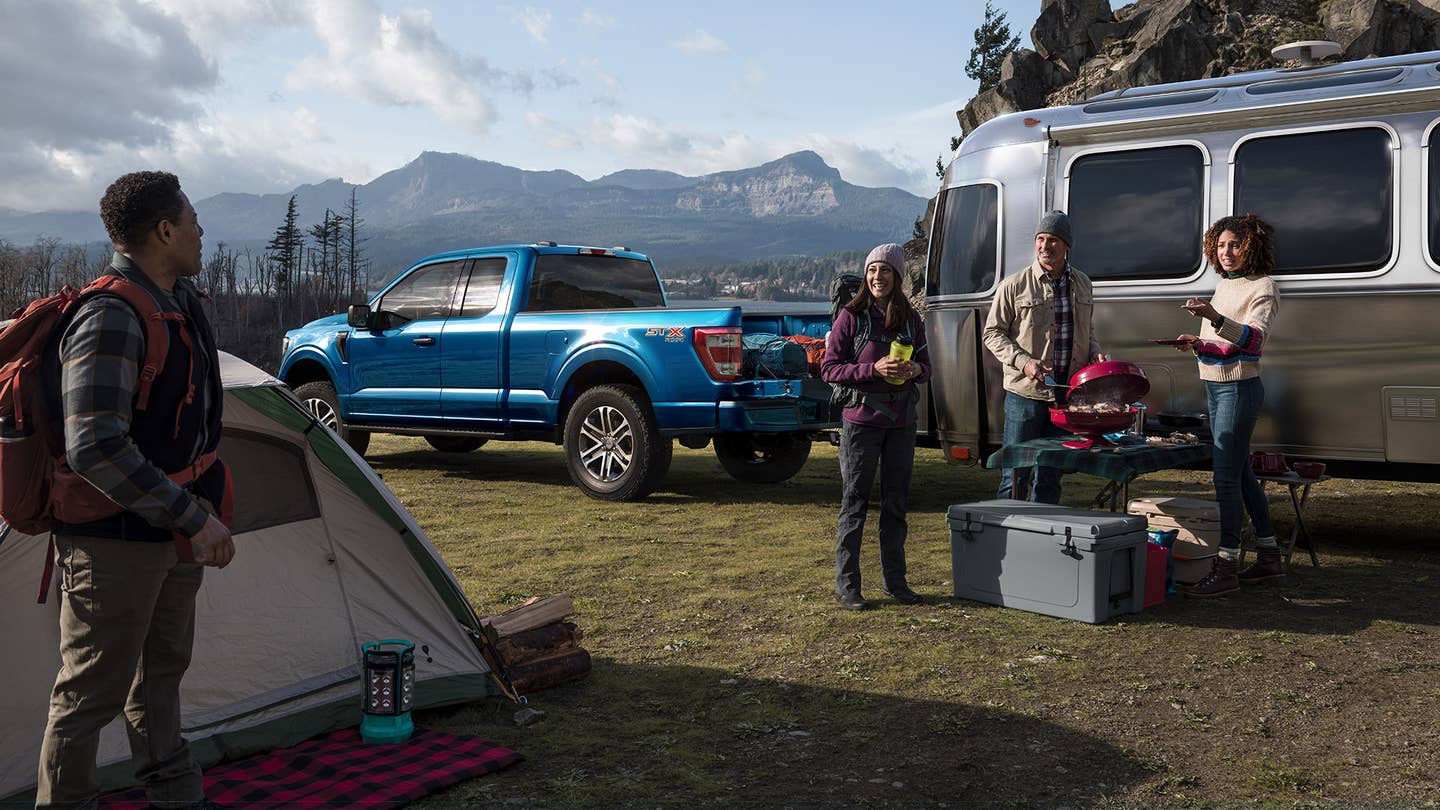
How Often Do You Need To Backup a Trailer?
- Every time a boat needs to be launched, a camper needs to be parked in a site, or a flatbed needs to be backed up a driveway.
How Much Does It Cost To Set Up a Trailer?
- Depending on the hitch type, needed accessories and labor, setting up your truck or SUV to towa trailer can cost anywhere between $10 and a couple thousand dollars.
Life Hacks To Backup a Trailer
Even with the right tools, the proper equipment and a high-tech truck, backing up a trailer can be a frustrating process. Take some of the guesswork out of the process with this simple and cheap hack.
- Pick up four wooden dowel rods, or any type of long straight stick, and put one at each corner. This will ease and aid trailer visibility and help the driver keep track of its size at all times. This is particularly helpful when a small trailer is obscured from view behind the large vehicle it’s attached to.

Featured Trailer Products
Tow Tuff Adjustable Trailer Dolly with Caster
Reese 7031400 Tri-Ball Mount with Hook
CURT 56070 7-Foot Vehicle-Side Truck Bed 7-Pin Trailer Wiring Harness Extension
Got a question? Got a pro tip? Send us a note: [email protected]


- Types Of RVs
- Tow Vehicles
- Maintenance & Repairs
- RV Power & Electrical Supplies
- RV Appliances
- Living In An RV
- Travel & Destinations
- RV Gear Buyer’s Guides
![8 Best Stabilizer Hitches for Travel Trailers in [currentyear]: Find the Perfect Weight Distribution Hitch 1 Best Weight Distribution Hitch](https://www.rvingknowhow.com/wp-content/uploads/2020/06/Best-Weight-Distribution-Hitch.jpg)
8 Best Stabilizer Hitches for Travel Trailers in 2024: Find the Perfect Weight Distribution Hitch
- Last Updated: March 19, 2024
- 40 minutes read
As someone who has rigorously tested numerous stabilizing solutions for travel trailers, I understand the importance of having a reliable weight distribution hitch to ensure safety and comfort on the road.
The right hitch can significantly alleviate the swaying and instability that often plagues trailers, making your journey smoother and worry-free.
Among the variety of options I’ve evaluated, focusing on anti sway hitch and spring bar technology specifically designed for travel trailers, one product stood out distinctly.
After testing 8 top contenders in the market, the Blue Ox BXW1000 SWAYPRO Weight Distributing Hitch earned its place as my best overall recommendation.
This hitch excels in providing superior sway control and weight distribution, ensuring your trailer remains steady in various driving conditions.
Based on my experience, the top stabilizer hitches for travel trailers are:
- Blue Ox BXW1000 SWAYPRO Weight Distributing Hitch : Best overall for its exceptional sway control and weight distribution.
- EAZ LIFT 48053 Elite Bent Bar Weight Distributing Hitch : Great for its bent bar design that enhances stability.
- Husky 32218 Center Line TS with Spring Bars : Excellent for integrating weight distribution and sway control in a robust design.
- Reese Pro 49903 Weight Distributing Hitch : Ideal for its versatility and ease of use.
- CURT 17063 MV Weight Distribution Hitch with Sway Control : Top choice for those seeking a durable and reliable option with integrated sway control.
- Camco Eaz-Lift ReCurve R6 Weight Distributing Hitch Kit with Sway Control : Perfect for those who prioritize easy setup and effective sway control.
- Andersen Hitches 3350 No Sway Weight Distribution Hitch : Best for its no-sway technology and lightweight design.
- Fastway 10K RB Fastway e2 2-point Sway Control Distribution Hitch : Good for its straightforward installation and efficient sway control mechanism.
8 Best RV Weight Distribution Hitches for Safe and Stable Towing
1. best overall: blue ox bxw1000 swaypro weight distributing hitch.
![8 Best Stabilizer Hitches for Travel Trailers in [currentyear]: Find the Perfect Weight Distribution Hitch 2 Blue Ox BXW1000 SWAYPRO Weight Distributing Hitch 1000lb Tongue Weight for Standard Coupler with Clamp-On Latches](https://www.rvingknowhow.com/wp-content/uploads/2024/02/31Mj36HuqiL._SL500_.webp)
The Blue Ox BXW1000 SWAYPRO is our pick for the best overall weight distribution hitch because it comes with a pre-adjusted hitch head that doesn’t require any further fine-tuning once it’s installed.
That’s not always the case with these hitches and it makes this a great choice if you don’t have a ton of experience using them.
This trunnion-style hitch has excellent sway control which allows you to tow at faster speeds without worrying about your trailer fishtailing behind you.
Trunnions on either side of the hitch head work together with the hitch’s spring bars to create a caster effect. This effect continuously pushes inward to keep everything in line.
You’ll also be able to navigate easier when you arrive at a new campground. Some locations have tight turns and others require you to back up to get into your site.
With this hitch, you won’t have to disconnect in order to back up. But when you do want to disconnect, it’s super easy to do so.
It takes just minutes to connect and disconnect to this hitch, which gives you the freedom to drop your trailer or vehicle without any added headaches.
If the tongue of your trailer already boasts a coupler welded to the top of the frame and it doesn’t have any cross-members on the tongue, you’ll be able to utilize this hitch out-of-the-box.
It is compatible with other trailer tongues, however. You just may need to purchase additional bolt-on latches or an optional hitch head to ensure safe towing.
The Blue Ox BXW1000 has a maximum tongue weight rating of 1,000 pounds and a maximum gross weight rating of 10,000 pounds.
It also boasts spring steel construction that adds durability and strength to the entire unit and you won’t have to disconnect this hitch when you need to back your trailer up.
Things We Like
- Sway Control: Keeps everything in line so you avoid fishtailing.
- Pre-Adjusted Hitch Head: Requires no additional fine-tuning after installation.
- Easy Connection: The spring bars on this hitch are self-locking.
- Clamp-On Latches: Don’t require the use of any additional hardware for installation.
Things We Don’t Like
- Compatibility: Works best with trailer tongues with coupler welded to the top of the frame and without cross-members on the tongue.
- Price: You’ll pay a little extra for the quality of this hitch.
2. Best Budget-Friendly: EAZ LIFT 48053 Elite Bent Bar Weight Distributing Hitch
![8 Best Stabilizer Hitches for Travel Trailers in [currentyear]: Find the Perfect Weight Distribution Hitch 3 EAZ LIFT Camco Eaz-Lift Elite 1,000lb Weight Distribution Hitch with Height Adjustable Forged Shank (48053)](https://www.rvingknowhow.com/wp-content/uploads/2024/02/41nnAFIsw8L._SL500_.webp)
The EAZ LIFT 48053 weight distribution hitch is the most budget-friendly round bar hitch we could find on the market today.
The good news is that you won’t have to severely sacrifice quality to get a hitch that fits your budget.
EAZ LIFT is actually made by Camco, which is one of the more reliable brands in the industry.
It comes with an adjustable ball mount but does not include the hitch ball itself. So you’ll have to grab this accessory separately to make this hitch work for you.
The bars on this hitch, however, are actually interchangeable. This is uncommon amongst this type of hitch but it serves to provide a smoother ride.
The bars use positive latching action to attach to your trailer tongue and the round spring bars on this hitch are machine tapered and forged longer for added strength and durability.
These spring bars can actually be removed if you chose to operate it as a more standard weight distributing hitch. Doing so, however, significantly reduces the hitch’s tongue weight and gross weight ratings.
The hitch is adjustable to fit many different trailer-vehicle combinations and it comes with clips and bolt package for easy installation.
The shank size is 2” x 2” with a 10-inch length, a 2.5-inch drop, and a 5.5-inch rise.
The entire package is also backed by the manufacturer’s 5-year warranty, which is always a good sign when it comes to your safety and the safety of your vehicle/trailer investments.
The EAZ LIFT 48053 also has a maximum tongue weight of 1,000 pounds and a maximum gross weight rating of 10,000 pounds. If you remove the spring bars, however, those ratings drop down to 600 pounds and 6,000 pounds, respectively.
- Price: It’s the most budget-friendly hitch on our list.
- Versatility: Spring bars can be removed to use it as a more standard hitch.
- 5-Year Manufacturer’s Warranty: Camco stands behind the quality of their product.
- Adjustable Hitch: Can adapt to fit a variety of trailer-vehicle combinations.
- Hitch Ball Not Included: You’ll have to purchase a compatible hitch ball separately.
3. Best For Quiet Use: Husky 32218 Center Line TS with Spring Bars
![8 Best Stabilizer Hitches for Travel Trailers in [currentyear]: Find the Perfect Weight Distribution Hitch 4 Center Line TS Weight Distribution Hitch - 2-5/16" Ball - 12,000lbs](https://www.rvingknowhow.com/wp-content/uploads/2024/02/3164m3UjsvL._SL500_.webp)
If you’re looking for a trunnion-style hitch that doesn’t cause a bunch of extra noise while you’re driving down the highway, check out the Husky 32218 Center Line TS.
Annoying noise can be an issue with other sway bars and weight distribution products, but that’s not the case with this hitch.
One of the reasons for this noise reduction is the fact that this hitch doesn’t use chains to attach to the tongue of your trailer.
Those chains jangling around are primarily what causes the noise in other models. But you’ll be able to hear (and feel) the difference when you drive with this hitch.
The unit combines sway control and weight distribution to provide quiet performance without the need for any additional hardware. This makes it super easy to install.
The handles on the bars further aid in securing them to (and removing them from) your trailer and the frame brackets are easily adjustable to mount on a variety of trailer tongues.
The Husky 32218 Center Line TS has a maximum tongue weight rating of 1,200 pounds and a maximum gross weight rating of 12,000 pounds.
The hitch itself weighs a total of 116 pounds, which is lighter than many. This lighter weight makes it easier to install and remove as needed.
- Quiet Operation: No noisy chains like other hitches.
- Built-in Sway Control: Doesn’t require installation of any additional hardware or accessories.
- Lightweight: This is a relatively lightweight hitch compared to similar models.
- Easy Installation: Handles on the frame brackets make it easier to install.
- Compatibility: This hitch is built for a 2 and 5/16” hitch ball.
4. Best With Preinstalled Hitch Ball: Reese Pro 49903 Weight Distributing Hitch
![8 Best Stabilizer Hitches for Travel Trailers in [currentyear]: Find the Perfect Weight Distribution Hitch 5 Reese Pro 49903 Round Bar Weight Distribution Kit with Sway Control](https://www.rvingknowhow.com/wp-content/uploads/2024/02/31u9q1VtAML._SL500_.webp)
The Reese 49913 Wd Rb Pro round bar hitch is a great option if you’re looking for a weight distribution hitch with a preinstalled hitch ball.
This means you won’t have to worry about finding a hitch ball separately and risk picking one that’s not compatible. With a preinstalled hitch ball, compatibility is a non-issue.
The hitch ball is 2 and 5/16ths of an inch in diameter and it arrives already torqued to the hitch head.
The spring bars on this hitch are tapered to provide more even weight distribution over your trailer axles.
This provides an even smoother ride and the include friction sway control prevents fishtailing at high speeds.
For an RV accessory that’s consistently exposed to dirt, debris, rain, and other elements, it’s important to know it’s going to last.
That’s why I like the fact that all the metal components of this hitch are finished with powder coating.
This finish improves the overall corrosion resistance and durability of the hitch over its lifetime.
In addition, the clamp-on brackets that come with this hitch are designed to fit trailer frames up to seven inches in diameter.
While this hitch won’t be compatible with larger trailer frames, the brackets don’t require any drilling to be installed properly.
This hitch also fits taller trucks with a two-inch shank size and an 8.5-inch drop.
The Reese 49913 Wd Rb Pro has a maximum tongue weight rating of 1,150 pounds and a maximum gross weight rating of 11,500 pounds.
It is also backed by the manufacturer’s 10-year limited warranty if certain components require repairs or replacement.
- Preinstalled Hitch Ball: Comes with a 2 and 5/16” hitch ball preinstalled.
- Powder Coat Finish: Improves corrosion resistance over the life of the hitch.
- 10 Year Warranty: The manufacturer offers a 10-year limited warranty on this hitch.
- Tapered Spring Bars: Provide more even weight distribution over the axles.
- Compatibility: Made to fit only bottom mount couplers.
- Specific Clamp Brackets: These brackets are designed to fit trailer frames only up to seven inches.
5. Best Gross Trailer Weight Rating: CURT 17063 MV Weight Distribution Hitch with Sway Control
![8 Best Stabilizer Hitches for Travel Trailers in [currentyear]: Find the Perfect Weight Distribution Hitch 6 CURT 17063 Round Bar Weight Distribution Hitch with Integrated Lubrication and Sway Control, Up to 14K, 2-In Shank, 2-5/16-Inch Ball , Black](https://www.rvingknowhow.com/wp-content/uploads/2024/02/4100TmBvPL._SL500_.webp)
If you’re in search of a weight distribution hitch with a high gross trailer weight rating, look no further than the CURT 17063 MV Round Bar hitch.
This hitch is the best option for anyone that needs to tow a longer trailer and it has a lot of great features to keep that extra length in line with your towing vehicle.
For starters, it provides more level towing by more evenly distributing the tongue weight of your trailer across the area of the vehicle-trailer combination.
In conjunction with the included sway control bar, your trailer will stay more level while you’re driving than with many other distribution hitches.
In order to improve sound on the road, this hitch includes an integrated lubrication system.
This system provides continuous lubrication through the use of two easy-access grease zerk fittings on the hitch head.
These fittings are built directly into the head and provide lubrication at the spring bar mounting location.
Speaking of the spring bars, they are each 31 and 1/16th of an inch long and made of forged steel.
The pre-torqued hitch ball is 2 and 5/16th of an inch in diameter and the shank size is 2” x 2”.
This shank size makes it compatible with class 3, class 4, and even the heaviest of class 5 trailer hitches.
The CURT 17063 MV Round Bar has a maximum tongue weight rating of 1,400 pounds and a maximum gross weight rating of 14,000 pounds.
It also boasts a durable black carbide powder coat finish to add durability and corrosion resistance to the components.
- Adaptability: Standard shank size fits class 3, 4, and 5 trailer hitches.
- Continuous Lubrication: Lubrication at the spring bar mounting location ensures a smoother ride.
- Level Towing: More even weight distribution at the tongue makes your trailer ride more level.
- Gross Vehicle Weight Rating: This hitch is rated a maximum gross weight of 14,000 pounds.
- Performance in Tight Spaces: Some users reported the need to disconnect the sway control bar when making tight turns, especially to the right.
6. Extra Ground Clearance: Camco Eaz-Lift ReCurve R6 Weight Distributing Hitch Kit with Sway Control
![8 Best Stabilizer Hitches for Travel Trailers in [currentyear]: Find the Perfect Weight Distribution Hitch 7 Camco Eaz-Lift ReCurve R6 Weight Distributing Hitch Kit with Adjustable Sway Control - 1000 lb. Tongue Weight Capacity |Heavy Duty and Rust Resistant Design - (48733)](https://www.rvingknowhow.com/wp-content/uploads/2024/02/31Kq8QQ3ySL._SL500_.webp)
If you consistently take your trailer to locations that require a little extra clearance, the Camco Eaz-Lift ReCurve R6 top-loading round bar hitch is one of the best in the business.
It’s specifically designed to provide more ground clearance than other hitches and the model’s sway control can temporarily be disengaged to provide better performance in icy or dangerous road conditions.
Unlike many hitches, the spring bars on this one are top-loading. This design feature creates more ground clearance and also makes them much easier to install.
This feature is aided by the fact that the shank itself only has a maximum drop of ¾”. It does provide a maximum rise, however, of seven inches.
Camco specifically designed this hitch to be one of the most user-friendly models in their fleet.
In doing so, they created a system that automatically disengages the sway control function when you turn.
With other hitches, the sway control function can essentially “lock” your trailer straight and it must be manually disengaged for tight turns or navigating into a campsite.
That isn’t the case with the ReCurve, which makes it much easier and efficient to navigate tight campgrounds or get your trailer into position in trickier spots.
This model comes with a 2 and 5/16” hitch ball and a 2” square hitch bar with a length of 12 inches. The spring bars themselves are 30 inches long.
The Camco Eaz-Lift ReCurve R6 has a maximum tongue weight rating of 1,000 pounds and a maximum gross weight rating of 10,000 pounds.
Like other good hitch models, the metallic components of this one are finished with powder coating to length their lifespan and provide added corrosion resistance.
- Ground Clearance: This hitch has a maximum rise of seven inches and a drop of only three-quarters of an inch.
- Top-Loading Spring Bars: This design further improves this hitch’s ground clearance.
- Sway Control Function: Automatically disengages on tight turns to make it easier to navigate.
- Adaptability: The sway control can also be completed turned off for better control in icy or otherwise dangerous road conditions.
- Price: This is definitely not the cheapest hitch on our list.
- Pin Design: Some users reported issues removing pins to re-position frame brackets after initial installation.
7. Best Anti-Sway and Anti-Bounce: Andersen Hitches 3350 No Sway Weight Distribution Hitch
![8 Best Stabilizer Hitches for Travel Trailers in [currentyear]: Find the Perfect Weight Distribution Hitch 8 Andersen Hitches 3350 | No Sway Weight Distribution Hitch | 4" Drop-Rise | 2 5-16" Ball | 3", 4", 5", 6" Universal Frame Brackets | Includes 2 Bumper Stickers](https://www.rvingknowhow.com/wp-content/uploads/2024/02/41zrNmtuJoL._SL500_.webp)
If you’re looking for a true pioneer in the weight distribution hitch industry, check out the first-in-its-industry features of the Andersen Hitches 3350.
This Andersen hitch is the first to include both anti-sway features and a motion dampening system that keeps your trailer from bouncing up and down at higher speeds.
The sway control functionality of this model is self-adjusting. This means it won’t lock you up on tight turns or when you’re navigating into a tricky campsite.
You’ll also be able to back your trailer up with this hitch still attached. So it can allow for more efficient trailer travel when compared to some other hitches.
The hitch ball that comes with this unit is 2 and 5/16ths of an inch in diameter.
It can actually double as a standard hitch ball if you ever need to tow anything without concern for weight distribution.
The hitch bar itself fits a two or 2.5-inch receiver and secures in place with a single pin. This guarantees easy installation and removal as needed.
This model has a maximum drop and rise of four inches, but you can purchase an eight-inch adjustable rack if you need additional drop or rise.
You also won’t need to worry about lubricating the ball and coupler regularly. They move as one as part of Andersen’s unique grease-free system.
The Andersen Hitches 3350 has a maximum tongue weight rating of 1,400 pounds and a maximum gross weight rating of 14,000 pounds when installed with the standard two-inch rack.
But it can actually handle a gross weight up to 16,000 pounds when installed with the 2.5-inch rack.
- Better Control: This is the first hitch of its kind to reduce both trailer sway and trailer bounce.
- Frame Bracket Adaptability: Brackets adjust to fit 3”, 4”, 5”, and 6” trailer frames.
- Grease-Free System: The ball and coupler actually move as one unit so no extra lubrication is required.
- Easy Installation: No pry bars needed!
- No Spring Bars: It relies, instead, on chains that can produce more noise on the road.
- Customer Service: Some users have reported trouble getting in touch with Andersen customer service.
8. Best Lightweight: Fastway 10K RB Fastway e2 2-point Sway Control Distribution Hitch
![8 Best Stabilizer Hitches for Travel Trailers in [currentyear]: Find the Perfect Weight Distribution Hitch 9 Fastway e2 2-Point Sway Control Round Bar Hitch, 94-00-1061, 10,000 Lbs Trailer Weight Rating, 1,000 Lbs Tongue Weight Rating, Weight Distribution Kit Includes Standard Hitch Shank, Ball is Included](https://www.rvingknowhow.com/wp-content/uploads/2024/02/31PqLRXdIOL._SL500_.webp)
The most lightweight round bar hitch on our list is the Fastway 10K RB e2 hitch.
It weighs a total of just 33 pounds, which is lighter than the nearest competitor by a wide margin.
This lighter weight makes the hitch and accompanying spring bars much easier to install and remove as a single person, whereas others might require at least two people for easier installation.
Despite its lightweight design, the rigid steel brackets on this unit mount directly to your trailer frame to prevent sway.
They do so by creating steel-on-steel friction and consistently applying pressure inward.
The sway control on this hitch is also completely built-in, which means you won’t have to install or connect any additional parts or hardware.
The hitch is designed to be back-up friendly, which means you won’t have to disconnect it every time you need to back into a new campsite. This can be an issue with other hitches, but not with the e2.
It also has the added advantage of being very adaptable ot many trailer types because the brackets are easily installed around gas tanks and battery boxes that are sometimes mounted on the trailer tongue.
The Fastway 10K RB e2 has a maximum tongue weight rating of 1,000 pounds and a maximum gross weight rating of 10,000 pounds.
The Fastway e2 hitch is also available in at trunnion-style if you require additional ground clearance. Or you can pop back up and check out the ReCurve R6.
- Product Weight: This distribution hitch weighs just 33 pounds.
- Built-in Sway Control: Keeps your trailer in line in without requiring any add-ons.
- Rigid Brackets: Create steel-on-steel friction to prevent sway.
- 10 Year Warranty: Covers repairs or replacements on most parts and components.
- No Hitch Ball Included: This unit works with a 2 and 5/16ths of an inch ball, but it doesn’t come with one.
How To Pick The Perfect Weight Distribution Hitch?
The right hitch for your situation will largely depend on compatibility with both your RV and your towed vehicle.
In this Buying Guide, we’ll cover the main factors that will help you determine whether a certain hitch will work for your RV-vehicle combination.
Types of Weight Distribution Hitches
There are three main types of weight distribution hitches. We’ve included at least one of each in our reviews above, so it’s important that we take some time to understand a little more about each type.
Round Bar Hitches
This type of hitch features round sway bars that attach to the bottom of the trailer ball mount. Their main advantage is compatibility with many different vehicle-trailer combinations.
But they have less ground clearance than other hitch types, so potholes or bumps can present problems.
Trunnion-Style Hitches
Trunnion-style hitches have much more ground clearance than a round bar or Andersen hitch.
The sway bars on this style of hitch also don’t require clips, but the downside of this hitch type is that it can be difficult to adjust the height of the hitch head.
Andersen Hitches
Andersen hitches completely ditch solid sways bars in favor of chains and dampers.
This hitch design does very well to reduce both swaying and bouncing, which is nice if you frequent rough roads or like to take your trailer off-road.
Gross Trailer Weight
The gross weight of your trailer includes the factory weight as well as the weight of any additional cargo or modifications.
Many new trailer owners forget to take these additional weights into account when they purchase a new hitch system, which can result in buying a hitch that isn’t rated highly enough.
To put it very simply, you need a weight distribution hitch that’s rated for more weight than the total weight of your trailer and all of its cargo.
If your trailer is too heavy for the hitch, it won’t be capable of properly distributing the weight. It will essentially be rendered useless and your trailer will still be more likely to sway or bounce.
Tongue Weight
Tongue weight is the percentage of the load that rests directly on the hitch. It is actually a combination of the weights of the front end of your trailer and the back end of your towing vehicle.
As a general rule of thumb, the tongue weight is typically about 10 to 15 percent of the gross trailer weight.
You should always choose a hitch that’s rated to handle more than the actual tongue weight of your trailer-vehicle combination.
If you can’t perfectly calculate the exact weights of the front end of your trailer and the back end of your towing vehicle, using the 10 to 15 percent rule of thumb is a great way to determine how much tongue weight your ideal weight distribution should be rated to handle.
Installation Process
Some hitches are much easier to install than others. But all of them will require a little bit of time and effort.
When selecting a weight distribution hitch, make sure to choose one with a relatively simple install process.
It should also come with a clear instruction manual that’s written precisely in the language you’re most comfortable with.
Most manuals should provide instructions in multiple languages, but this is indeed something to check on before buying.
And one great way to do that is by reading into user reviews of the specific hitches you’re interested in.
If you can find a hitch that users are continuously reporting to be easy to install, you can rest assured that your own process won’t become a tedious headache.
In general, the installation process for these hitches shouldn’t take more than one hour.
If you’re finding reviews that state it took multiple hours to install a certain hitch, you might be well served avoiding that product.
But you always need to be careful not to judge a hitch based on a single user review. Look for patterns and identify the experience that the majority of users are reporting.
A weight distribution hitch with a simple installation process should require between 30 minutes and one hour to set in place properly.
Types Of Sway Control
Almost all weight distribution hitches have some form of sway control. But the way they work can be drastically different.
One type of sway control is designed to reduce sway once it has begun. The other is designed to prevent swaying from starting in the first place. We’ll go over each type in more detail.
Sway Controls To Reduce Sway
Hitches that serve this purpose either rely on independent friction sway control or dependent sway control.
Independent friction control devices on weight distribution hitches typically look like a bar that attaches to the frame of your trailer.
Because the bar is attached to both the hitch and your trailer, it can provide tension to keep your trailer straighter behind your vehicle.
The bar is usually telescoping so that it can extend or retract as your trailer moves.
If your trailer starts to move out of line, the friction pads within the telescoping arm of the bar keep it from extending too far, which cuts down the side-to-side movement of your trailer.
Dependent sway controls are actually built right into a weight distribution hitch.
When your trailer begins to swing, the downward force created by the hitch’s spring bars creates frictional resistance on the brackets connected to your trailer frame.
Some dependent sway control devices rely on steel-to-steel resistance. Others include a material that is similar to the brake pads on a vehicle.
Either way, the resistance created is designed to keep your trailer in a straight line.
Sway Controls To Prevent Sway From Starting
There are various types of weight distribution hitches with sway controls designed to prevent sway from beginning in the first place.
One such device relies on sliding devices called ‘cams.’ These ‘cams’ suspend the spring bars and lock into position.
With one end of the cam aligned to the lift bracket and the other to your trailer frame, the springs bars are set in place. This placement of the spring bars is what keeps your trailer aligned.
Some hitches have four points of sway control built-in. This entails a secure connection between the hitch head and the spring bars.
Through these connections, the spring bars are held tightly in place and the amount of tension and resistance in the system is enough to keep your trailer in line.
Still other hitches rely solely on tension to keep the spring bars tightly in place. And there are also systems with active sway control that rely on spring-loaded ball bearings.
These bearings apply pressure inside the detents in order to keep the trailer straight.
Product Weight
The weight of the weight distribution hitch you choose should be taken into account when you’re making sure that the total weight you’re hauling doesn’t exceed your vehicle’s specifications.
While these hitches help to more evenly distribute the weight of your trailer and rear axle of your tow vehicle, they can’t actually increase the maximum towing capacity of your vehicle.
But the weight of the hitch you choose also comes into play when you have to install or remove it.
Most of these hitches weight at least 100 pounds, but some are considerably heavier while others are noticeably lighter.
Simply make sure that you’re comfortable handling the weight of the hitch you choose when it comes to installing it between your tow vehicle and your trailer.
Pre-Installed Components
The best weight distribution hitch models come ready-to-use right out of the box. They include all of the pre-installed components necessary for easy installation and safe operation.
Many also include a package of clips and pins to secure the hitch bar, brackets, and other elements in place.
But other hitches don’t come with everything you need to start using them immediately. Some don’t include a hitch ball and you’ll have to buy that separately.
Others might require additional hardware to be compatible with your specific trailer-vehicle combination.
If this becomes the case for you, you’ll have to incur an added expense to make the hitch you’ve already bought work with your trailer. And that’s not always the easiest task to complete.
So we recommend looking for a hitch that comes with pre-installed components.
Taking this route will also reduce the likelihood that anything happens during the installation process that causes the entire weight distribution system to be dangerous or ineffective.
As you might expect, these hitches are subject to the elements. Roadways can be harsh environments for any exterior components of your trailer and vehicle, but your hitch rests firmly in between the two.
And this positioning can place even more stress on the hitch and its components. That’s why you need to consider the durability of a given hitch in your buying process.
The most durable hitches on the market include a powder-coated finish to whatever metal is used in their construction.
This powder coating provides an added degree of corrosion-resistance that extends the longevity of your hitch and its components.
If you live or frequently travel to locations close to the ocean, you probably already know the effect that salt in the air can have on metal parts.
So a hitch with a powder-coated finish is essential for these areas.
But the durability of a weight distribution hitch extends a little bit beyond whether or not it has a corrosion-resistant finish.
The quality of the metal used in the hitch’s construction also comes into play.
Perhaps the easiest way to ensure that your final hitch choice is going to last is to consult a host of consumer reviews.
You can be confident that any product with a durability issue is going to have plenty of reviews in which that issue is well documented.
Again, be careful to trust the “law of averages” when it comes to consulting these reviews.
But they can still be a very helpful tool in determining whether or not a hitch will actually hold up as well as its manufacturer claims.
How much does a weight distribution hitch cost?
When it really comes down to making a final decision on a hitch, we know that its price is going to come into play. And we recognize that these hitch systems aren’t always super affordable.
But we also think it’s important to point out that what we’re really talking about here is an investment into your personal safety, your family’s safety, and the safety of the investments you’ve made in your trailer and your tow vehicle.
We know that some of those things are hard to put a price on, and there are ways to reduce trailer sway without purchasing a weight distribution hitch.
But the best ways to ensure safer towing are to purchase a quality weight distribution hitch and apply some of those safe driving techniques.
In the process of setting your budget for a weight distribution hitch, it’s good to get a sense of the high and low ends of the market.
This will give you a range in which most hitches will fall, and then you can more easily decide which end of that range you’d like to select from.
So, What is the Best Weight Distribution Hitch for 2020?
As we stated in our initial reviews, we stand by the Blue Ox BXW1000 as the best overall weight distribution hitch.
It gets our vote here because it’s super user-friendly if you’re new to the world of towing a trailer.
The latches that attach to your trailer frame don’t require any additional hardware and the entire hitch can be installed or removed in just a few minutes.
But, coming in a close second, we’d also highly recommend the Camco Eaz-Lift ReCurve R6 hitch.
This is because it offers more ground clearance than the majority of weight distribution hitches on the market.
This extra clearance will definitely come in handy if you like to travel off the beaten path.
Frequently Asked Questions About WDH
While these hitches aren’t overly complicated, there’s still quite a bit to learn if you’re buying your first one.
So let’s briefly address the most frequently asked questions about weight distribution hitches.
What size hitch do I need?
The main factor that will determine your hitch size is the weight of your trailer (or towed vehicle).
A hitch’s size is usually determined using two ratings: one for maximum gross trailer weight and the other for maximum tongue weight.
These two ratings are very commonly advertised when you’re shopping for weight distribution hitches.
If it’s hard to find these ratings for a particular model, that’s an automatic red flag.
To pick the right size hitch for you, make sure that these ratings are both higher than the gross weight of your trailer and its tongue weight.
These weights should be relatively easy to find in the specifications for your trailer, whether that’s online or in the owner’s manual.
But you should also be careful not to choose a hitch that’s rated too high. If your actual tongue weight is much less than what your hitch is rated for, it can actually make towing unpredictable and more dangerous.
On the other hand, a hitch that’s rated for less than the actual tongue weight of your trailer won’t be able to adequately distribute the load and, in that case, there’s not much point in having it.
How does weight distribution really work?
These hitches work by distributing weight away from the tongue of your trailer and onto the other axles of your vehicle.
Without weight distribution, all of the weight of your trailer gets concentrated on the rear axles of your towing vehicle.
With weight distribution, that weight gets spread to the front axle of your towing vehicle and the axles of your trailer itself.
This effect becomes really helpful for not exceeding the gross vehicle axle weight limit of your towing vehicle.
As a general rule-of-thumb, you should consider a weight distribution hitch if the weight of your trailer is more than half of the weight of your towing vehicle.
Can you further explain sway control?
Sure! Breaking it down briefly, there are devices that reduce sway once it has begun and others that are designed to prevent sway from starting in the first place.
Most of the best weight distribution hitches have one of these two forms of sway control built-in.
How do I know how much my vehicle can tow?
It’s important to note that none of these hitches boast the ability to increase the amount of weight that your vehicle can tow.
It safely makes towing a trailer safer and makes your trailer less likely to fishtail or bounce at higher speeds.
Your vehicle’s rating for the maximum amount of weight it can tow safely and legally should be in your owner’s manual.
Otherwise, you can most likely find the specifications online as long as you know the exact year, make, and model of your vehicle.
If you can’t find the information online and you’ve misplaced your owner’s manual, you can always call the dealership that you bought your vehicle from.
This, of course, only works if you bought from a dealership and not a private seller.
But going directly to the manufacturer can still be a good way to find your vehicle’s towing specifications if you did purchase from a private party.
What are the main problems with towing a trailer without a weight distribution hitch?
The two main problems that occur when towing a trailer are called ‘dive’ and ‘sway’. If the tongue weight is too large in comparison to your gross trailer weight, the trailer will ‘dive’.
This basically occurs when there is too much weight placed on the hitch junction between your vehicle and your trailer.
This excessive weight causes the tongue of the trailer and the rear axle of your tow vehicle to dive down together.
This creates a sort of ‘taco effect’ that will be visible to the naked eye if it’s occurring. The back of your trailer will be noticeably higher than the front once it’s loaded onto your trailer hitch.
You’ll also be able to see the nose of your tow vehicle visibly higher than the rear bumper. The danger of a ‘dive’ comes when you try to brake quickly.
The added downward force placed on the hitch junction can cause the nose of your tow vehicle to lift up.
This can cause you to lose braking traction and steering control through the front axle of your vehicle.
The other main problem with towing without a weight distribution system is ‘sway’. It happens when the tongue weight is too low and the back end of your trailer is too heavy.
The excess weight in the rear can cause the tail end of your trailer to swing one way and then forcibly back in the other direction. In mild cases, sway can cause you to lose control of your tow vehicle.
In more extreme cases, it can actually cause your trailer to flip over and, when this happens, it often takes your tow vehicle with it.
This poses a serious risk to passengers onboard as well as other drivers on the road.
Are there ways to reduce ‘sway’ without a weight distribution hitch?
The short answer is yes. But before we get into a few brief recommendations, it’s important to definitively state that we think a weight distribution hitch is the best way to reduce trailer sway.
Our true recommendation would be to use these techniques along with (rather than in place of) one of the best weight distribution hitch options we reviewed above.
But one good way to reduce sway is to avoid crosswinds. If you keep an eye on the weather forecast and know that heavy winds are expected on your route, it may be best to delay your trip until winds subside.
If you have to travel when winds are high, it’s best to drive significantly slower than normal.
Another way to reduce sway is to make sure the weight inside your trailer is distributed evenly.
If you have a trailer with a single axle, it’s a good practice to align about 60 percent of the weight in front of, or on, the axle.
This helps to avoid a low tongue weight, but you also need to make sure the load is balanced from side-to-side and everything inside your trailer is secured down adequately so that it doesn’t shift while you’re driving.
Additionally, the air pressure of your tires can have an impact on trailer sway. Tires that aren’t properly inflated can cause the trailer to sway more than normal, so be sure to check your tire pressure if you’re experiencing irregular sway when towing your trailer.
Attempting to tow a trailer that is far too long for your towing vehicle is also a surefire way to experience more sway.
For example, towing a trailer with an SUV that’s less than one-third of the trailer’s length is just asking for trouble.
Make sure your trailer-vehicle combination is appropriate to avoid unnecessary towing issues like sway.
Finally, your driving practices can cause your trailer to sway even if you’ve done everything else right.
Driving too fast and braking too suddenly are two easy ways to cause your trailer to sway. Sudden turns of your steering wheel should also be avoided.
If your trailer does begin to sway, it’s really important that you don’t try to steer out of it or speed up.
The only good way to reduce sway and regain control of your trailer at this point is to keep the wheel straight and gradually apply your brakes.
As someone who has moved to a new city in an RV and spent the first several weeks commuting to and from work in that RV, I highly recommend a weight distribution hitch for towing an additional vehicle behind your rig.
This is an essential RV accessory for full-time RVers or those that like to spend an entire season in their rig.
The ease and convenience of not having to go through the process of prepping your RV to roll every time you need to make a trip into town will make the cost of a weight distribution hitch worth it every single time.
About Author / Aaron Richardson
Aaron Richardson is an expert RVer and the co-founder of RVing Know How. Aaron, along with his wife Evelyn, has been living and traveling in their Keystone Fuzion RV since 2017. Their adventures span across the country and beyond, including memorable RVing experiences in Mexico. Aaron's passion for the outdoors and RVing shines through in his writings, where he shares a blend of travel stories, practical tips, and insights to enhance the RV lifestyle.
![15 Best Van Conversion Companies in [currentyear]: Top Rated Camper Van Builders 10 Best Van Conversion Companies](https://www.rvingknowhow.com/wp-content/uploads/2020/04/Best-Van-Conversion-Companies-150x150.png)
15 Best Van Conversion Companies in 2024: Top Rated Camper Van Builders
8 best hard-sided pop-up campers in 2024 – expert pop up campers guide.
![8 Best Hard-Sided Pop-Up Campers in [currentyear] - Expert Pop Up Campers Guide 11 Best Hard-Sided Pop Up Campers](https://www.rvingknowhow.com/wp-content/uploads/2021/11/Best-Hard-Sided-Pop-Up-Campers-150x150.webp)
You Might Also Like
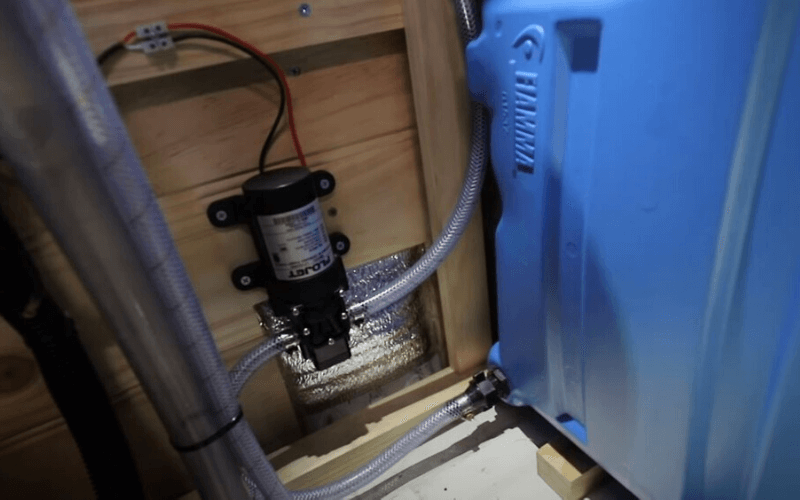
8 Best 12 Volt RV Water Pumps For Your camper or motorhome
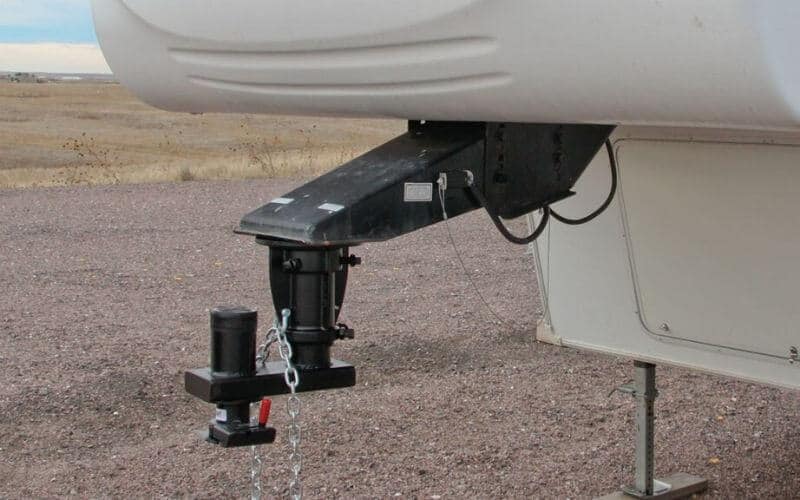
The 5 Best Adapters for Towing a 5th Wheel with a Gooseneck Hitch
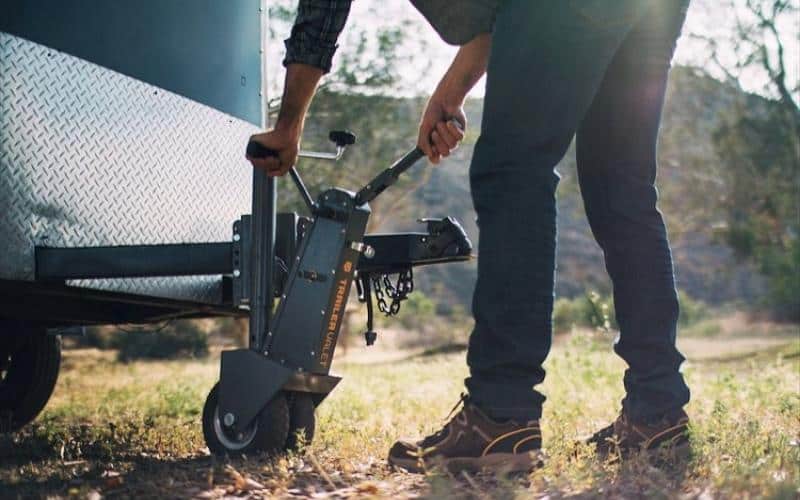
Best Motorized trailer dolly to move your RV camper safely
Start typing and press Enter to search

RV Hitch & Tow
Last updated on: January 4, 2022
The 12 Best Weight Distribution Hitches to Buy in 2022
by Chris Coleman
www.rvtalk.net is reader supported. When you buy through links on our site, we may earn an affiliate commission.
While towing your trailer, one of the most important priorities is to maintain control over your towing setup to minimize the odds of accidents. A way to ensure safe towing and good handling on the road is to get the best weight distribution hitch . By ensuring that your rig packs the right hitch before every towing operation, you can stabilize your towing setup and avoid common issues such as swaying.
To determine the best weight distribution hitch for your circumstances, you certainly need to do your homework to understand their components and working mechanism, the different types of weight distribution trailer hitches, their benefits and when you would need one, the most important buying criteria and a few dos and don’ts. This article will equip you with everything you need to know about weight distribution hitches, and provide answers to the most frequently asked questions by your fellow campers.
Best Weight Distribution Hitches Comparison Chart
What is a weight distribution hitch, when you would need a weight distribution hitch, components of a weight distribution system, how does a weight distribution hitch work , benefits of weight distribution hitches, types of weight distribution hitches, 1. andersen 3350 – best of the best , 2. curt 17007 – editor’s choice, 3. camco eaz-lift 48056 – editor’s choice , 4. camco eaz-lift 48053, 5. equal-i-zer 90-00-1000, 6. husky 31423, 7. curt 17062, 8. reese pro series 49913, 9. fastway e2, 10. husky 32218, 11. camco eaz-lift 48733, 12. blue ox swaypro bxw1500, critical weight distribution hitch considerations, top brands of weight distribution hitches, q1. do weight distribution hitches reduce tongue weight, q2. does a weight distribution hitch increase towing capacity, q3. how much weight does a weight distribution hitch distribute, q4. when do you need a weight distribution hitch, q5. can weight distribution be used with surge brakes, q6. how to stop your trailer from swaying on the road, q7. what is the best weight distribution hitch with sway control, weight distribution hitch basics.
A weight distribution hitch , also referred to as a load equalizing hitch, does exactly what the name suggests. It is a hitch that evenly distributes the weight of your payload that you tow behind your vehicle.
A weight distribution hitch does this by using adjustable spring bars and tension to distribute the load of the trailer tongue to the trailer and the towing vehicle axles. A trailer’s tongue weight (TW) refers to the weight that a fully loaded trailer exerts downward on the hitch ball of the tow vehicle. Tongue weight should be between 10% to 15% of gross trailer weight (GTW) for good control and handling on the road.
As you already know, driving a vehicle with a trailer towed behind, connected by a hitch is very different from driving a vehicle alone in terms of handling, due to the added weight and size as well as the swaying from side to side. Without the proper hitch and the best weight distribution hitch, you might have a very hard time maneuvering and thus the risk of accidents is significantly higher. The purpose of getting the best weight distribution hitch is to keep everything balanced, so that you gain more control of the towing vehicle and trailer combo as they turn and brake.
When you’re towing a trailer, what comes into play are the tow vehicle’s weight, the trailer’s weight and the weight put on the hitch ball. The relationship between these factors will affect your handling on the road. In other words, what matters to controllability here is the trailer’s tongue weight, that is the weight that a fully loaded trailer exerts downward on the hitch ball of the tow vehicle.
Firstly, if the trailer’s tongue weight is too light, that is the tongue of the trailer does not exert enough downward force on the tow vehicle’s hitch ball, the trailer could sway from side to side and this can result in dangerous accidents. On the other hand, if the tongue weight is too heavy, the steering of the tow vehicle will be affected.
The good news is you can avoid both of these issues by using the best weight distribution hitches to maintain the ideal balance between the gross trailer weight and tongue weight.
You can weigh your trailer by taking it to a commercial scale at truck stops. The rule of thumb is 10% to 12% of the trailer’s weight must be on the tongue where it hitches to your vehicle. So for example, if the gross weight of your trailer is 2,500 pounds, then at least 10% of that weight should rest on the hitch, or in other words, the trailer’s tongue weight should be about 250 pounds.
In general, if you’re experiencing one or more of the following, you’re most likely to benefit from a trailer weight distribution hitch:
- Your gross trailer weight (GTW) is more than 50% of your tow vehicle’s gross vehicle weight rating (GVWR). The Gross Vehicle Weight Rating is the maximum total safe weight of your vehicle, including the curb weight or the weight of your vehicle when empty, the weight of passengers, fuel, any accessories added to the vehicle, cargo, and the tongue weight of the towed trailer.
- Difficulty when maneuvering: You experience trailer sway, or find it difficult to steer or stop your rig.
- Your tow vehicle’s headlights point upward, and/or the rear of your tow vehicle sags when the trailer is hooked up. This means too much weight is resting on the rear of your tow vehicle, which greatly affects handling.
- You want to tow to the highest capacity allowed by your trailer hitch. If your hitch is rated for use with weight distribution, a good weight distribution system will allow you to tow at the maximum capacity of the hitch.
* Important note: Keep in mind that not all hitches are designed for use with weight distribution systems. Every trailer hitch will have a weight rating label; always check it for the weight distribution towing capacity. If there is no such capacity specified, then a weight distribution system cannot be used with the existing hitch.
A typical weight distribution system consists of five major components:
Class III, IV, or V trailer hitch receiver: As above, the trailer hitch receiver must be rated for use with weight distribution. It attaches to the frame of your tow vehicle and provides the receiver opening that the weight distribution shank slides into.
Weight distribution shank: The weight distribution shank slides into your trailer hitch receiver to create an attachment point for the weight distribution head assembly. To ensure your trailer is level with your vehicle, manufacturers make shanks available in a wide variety of lengths, rises and drops.
You can purchase a weight distribution hitch that comes with a shank, or you can purchase a hitch and a shank separately. Campers would usually opt for separate purchases when they require a greater rise or drop than provided by the standard shank included in the kit.
Spring bars: Spring bars redistribute the load on the rear of your tow vehicle to all the axles on your tow vehicle and trailer. Spring bars come in round, trunnion, and square shapes.
Frame brackets: Available in various designs, frame brackets mount to the frame of your trailer and secure the spring bars to the trailer. Standard weight distribution systems use a frame bracket and chain system to hold the spring bars in place. Meanwhile, many higher-end systems have special sway-control brackets for superior anti-sway capability.
Weight distribution head assembly: Head assemblies attach to the weight distribution shank, provide a place to mount the hitch ball for trailer hookup, and provide the spring bar attachment point. The head assembly will also be used to fine-tune the amount of leverage applied to the system. Different weight distribution systems use different types of head assembly, so the design differs between products.
As a highly sought-after feature, many standard head assemblies have built-in platforms for mounting friction sway control bars. Friction sway control bars mount to a smaller ball on the side of the weight distribution head. Some heads have dual platforms so that you can mount a sway control bar on either side or both sides)of your trailer, while some models only allow for a right-side attachment.
To understand how a weight distribution hitch comes into play when you tow a heavy trailer behind your vehicle, it’s important to understand the physics behind the setup. When you tow a trailer with a standard, rear-mounted hitch, the trailer’s tongue weight is rested on or transferred to the rear axle of your tow vehicle. Too much weight can make your vehicle’s back sag and cause the front to point upward, especially on vehicles that have suspension designed for everyday comfort.
When the front of your tow vehicle points upward, this means that most of the weight of the tow vehicle is resting on its own rear axle, and on top of that, it is also bearing the weight of the traileras well. This, plus the lessened weight on the vehicle’s front axle obviously has a negative effect on traction, steering and your ability to brake, and can increase the magnitude of trailer sway. The vehicle’s front pointing upwards might also mean that your view of the road may be limited due to the awkward angle.
So how does a weight distribution hitch help? A weight distribution hitch would redistribute the weight away from the tongue and onto the axles of the towing vehicles. This reduces the load that the rear of towing vehicles has to bear. This even redistribution of weight results in a smoother, level ride, and also allows you to tow at the maximum capacity of your hitch.
One important note that we must emphasize: Many campers misunderstand that weight distribution hitches can “reduce” tongue weight. This is not true. In other words, these systems won’t allow you to tow beyond the capacities of the tow vehicle.
If your hitch is rated for use with weight distribution, a good weight distribution system will allow you to tow at the maximum capacity of the hitch. So a weight distribution hitch allows the hitch to be used at its maximum capacity but doesn’t increase the hitch’s capacity.
Learn more on how it works here !
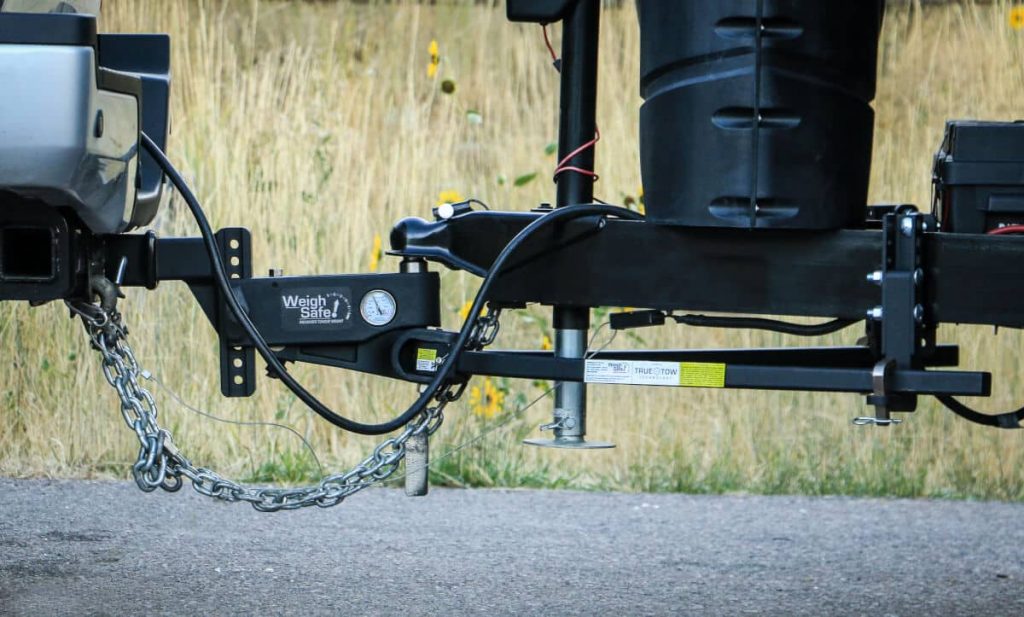
Controllability : With weight distribution trailer hitches around, the weight of towing setups should be equally spread among the axles instead of concentrating at the rear of your tow vehicle. This allows for a more balanced weight distribution and thus helps you gain more control of your towing setup.
Safety : Maneuvering with a trailer behind is no easy game; it demands practice and skills. It’s much more challenging than normal driving and the risk of accidents is higher, but using a solid weight distribution hitch for hauling heavy loads would allow you better handling. Even when you come across something unexpected, having a good hitch would allow you to have better control of the whole setup and to better respond in a timely manner.
Cost : Managing trailers is never easy and all it needs is one moment of carelessness for your trailers to sustain damages that incur expensive repairs. By picking up a trailer weight distribution hitch for enhanced control , you should have no trouble keeping your pricey trailers out of harm’s way.
Generally, weight distribution hitches come in all sizes and shapes but today’s market contains three types of models: round bar, trunnion bar and Andersen.
Round Bar Hitches
Basic and practical, round bar hitches work superbly in multiple towing setups. Carrying round sway bars that attach to the bottom of ball mounts of trailers, models of the type could consistently distribute weight of the vehicles. On the downside, due to less than ideal ground clearance, round bar hitches don’t do very well on backroads.
Trunnion Bar Hitches
In use, trunnion bar hitches operate similarly to round bar ones but instead of round, their sway bars happen to be square. Moreover, since the sway bars attach to the center of ball mounts of trailers, models of the type tend to boast top-notch ground clearance. However, it usually takes a bit of time to change the height of the hitch head.
Andersen Hitches
Unlike other hitches, Andersen hitches do away with sway bars in favor of highly flexible chains and dampers. With models of the type, people would be able to keep bouncing and swaying to the minimum while traveling. Andersen hitches have steep prices though so it’s necessary to be thorough about shopping budgets.
Reviews On The Best Weight Distribution Hitches
Preferences often differ significantly between people so there is no such thing as the best weight distribution hitch for everyone. Still, if you wish to get to know top-performing hitches then you have to check out the following models.

Why This Is The Best:
Designed from the ground up with practicality in mind, Andersen 3350 works like a charm in a wide range of situations. Possessing excellent weight ratings, the Andersen weight distribution hitch allows people to haul all sorts of loads with relative ease. Additionally, with a combination of self-adjust sway control and motion-dampening system, 3350 provides users with fantastic control over trailers. As a result, those that hit the road with heavy-laden trailers think of Andersen 3350 as the best weight distribution hitch at its rice range.
In terms of installation, the setup process of 3350 is undemanding and there is no need to resort to pry bars. On arrival, the hitch of Andersen is accompanied by everything so it’s unnecessary to make separate purchases for hardware. When positioned and secured, Andersen 3350 is going to serve you until the day it breaks down without requiring special attention. Interestingly, since 3350 is engineered with one-pin removal, you could detach it in a blink of an eye as well.
As proof of confidence, Andersen offers its hitch with a marvelous lifetime warranty that covers manufacturing defects which speak volumes. If your 3350 experience issues in the course of operation, you have something to count on.
- Installation is child’s play
- No-nonsense maintenance
- Customer service is less than ideal
- Users detect several inconsistencies between hitches

Why It’s An Editor’s Choice:
Featuring head and spring bars that employ top-of-the-line steel, Curt 17007 is praised for its outstanding structural integrity. Also, the integration of carbide powder coat finish means 17007 could handle heat, humidity, sunlight and so on without much difficulty. Thus, regarding longevity, the weight distribution hitch made by Curt is among the top-ranked models in its price range. Curt 17007 packs a decent weight capacity as well, hence, it suits plenty of towing operations.
The hitch of Curt incorporates an adjustable shank that is compatible with all standard two-inch trailer hitch receivers and that makes it highly versatile. Moreover, with snap-on brackets, 17007 mount onto the frames of trailers in a flash and via the lift handle, leveraging it is a cakewalk too. That is why no matter the arrangement, the setup process of Curt 17007 rarely drags out and everything the users need lies in the rig toolbox. Since the hitch from Curt is a breeze to maintain on the road, keeping it operational is an easy task.
When you opt to pick up Curt 17007, you would receive a terrific lifetime manufacturer warranty so you don’t have to be concerned about defects. Aside from that, the Curt hitch is fairly inexpensive so its purchase would have inconsequential effects on your upcoming spendings.
- Smooth operation
- Detailed installation instructions
- Certain hitches arrive with signs of damages
- Hardly adequate packaging
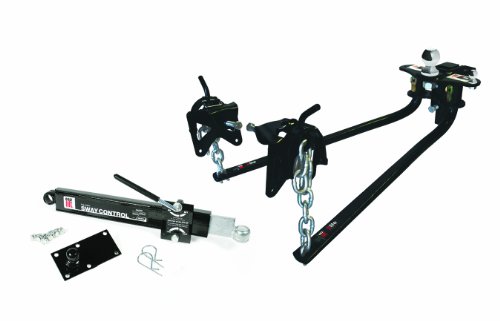
Dependable and reliable, Camco Eaz-Lift 48056 usually gives a good account of itself in use which earns it numerous compliments. Upon purchase, the hitch made by Camco comes pre-installed with the hitch ball, sway control, U-bolts and chains. Because of that, people could begin installing Eaz-Lift 48056 the moment it leaves the packaging and wrap up the setup process in a few minutes. In addition, boasting a black exterior that is aesthetically-pleasing, Camco Eaz-Lift 48056 matches the color themes of various rigs.
Constructed using premium steel, Eaz-Lift 48056 features wonderful endurance compared to the average weight distribution hitches on the market nowadays. From elements in the outdoors to physical impacts, the hitch from Camco is capable of dealing with all towing challenges. Therefore, even if Camco Eaz-Lift 48056 is used on a daily basis, years would pass before it must be replaced. Needless to say, Eaz-Lift 48056 is highly sought after by those that hate to spend money on frequent hitch replacements.
Available at an affordable price, Eaz-Lift 48056 of Camco is the best weight distribution hitch for people with tight wallets. Besides that, so as to reassure users, Camco willingly backs its weight distribution hitch with a five-year manufacturer warranty.
- Long-lasting
- Setup process is instantaneous
- Quality control still leaves something to be desired
- Reports of loosening bolts appear sporadically

Why We Love It:
With the ability to deliver significant boosts to controllability of towing setups, Camco Eaz-Lift 48053 is held in high esteem by a lot of people. As it consists of far fewer parts than its contemporaries, Eaz-Lift 48053 possesses first-class reliability in the course of operation. Packing positive latching action, the towing hitch of Camco is also simple to operate. Naturally, once it comes to convenience, Camco Eaz-Lift 48053 is known as the best weight distribution hitch money can buy.
Regarding capacity, the hitch made by Camco is put together with a GTWR of 10,000 pounds and a TW of 1,000 pounds. That is going to be more than enough to let users tow an assortment of trailers at their max load. Furthermore, the ball height of Eaz-Lift 48053 is adjustable so adapting it to variable arrangements is a piece of cake. About maintenance, pretty much all the hitch of Camco need to stay in working order is periodical cleaning and lubrication.
For post-purchase support, Camco Eaz-Lift 48053 is backed with a five-year manufacturer warranty. If your Eaz-Lift 48053 fails due to defects within the warranty period, you could claim a replacement free of charge. It’s worth pointing out since the Camco hitch is a low-priced model, the cost of replacement remains budget-friendly after the warranty expires.
- Inexpensive
- Decent capacity
- Easy to install
- People sometimes complain about missing hardware
- Packaging is mediocre
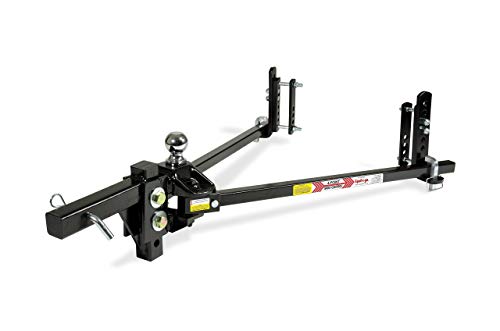
Tired of frantically fighting with swaying while maneuvering your towing setup on the road and need an anti-sway hitch ? Then there is a good chance that you would come to like Equal-i-zer 90-00-1000. Owing to the solid 4-point sway control, the hitch from Equal-i-zer is able to effectively and efficiently restrict horizontal motions of the trailers. That is why with 90-00-1000 installed on your rig, you should have no trouble keeping everything under control at all times.
The setup process of Equal-i-zer 90-00-1000 involves no drilling or tapping so it only takes mere moments to complete. Assuming that the installation is done correctly, 90-00-1000 should work smoothly without making a racket in use which ensures quiet operation. Unsurprisingly, those that seek tranquility think of the Equal-i-zer as the best weight distribution hitch available for purchase. Aside from that, being specifically created for universal application, the compatibility of 90-00-1000 of Equal-i-zer is terrific as well.
In terms of maintenance, the towing hitch made by Equal-i-zer could be cleaned and lubricated in no time. Hence, if you grab 90-00-1000, you may spend more time towing and less time maintaining accessories. Though its steep price, the values that Equal-i-zer 90-00-1000 provide match what it costs.
- Low noise level
- Sturdy and stable
- Maintenance is no sweat
- Fitness difficulty is noted
- Particular hitches show up without hardware

Capable of equally distributing heights of various towing setups, Husky 31423 earns positive remarks from plenty of weight distribution hitch reviews. Featuring a hitch head that could accept spring bars of variable capacities, 31423 adapts rather well to a diversity of operations. Moreover, with multiple built-in height levels, the hitch made by Husky allows people to quickly raise and lower it depending on the current situation. As a result, regarding versatility, Husky 31423 proves to be second to none on the market.
Covered in black polyester finish that packs wonderful resistance against corrosion, the Husky weight distribution hitch rarely experiences rust problems in the course of operation. Thus, 31423 is kind of popular among people that have to haul heavy loads through coastal regions from time to time. Also, the installation of Husky 31423 is quite intuitive so you don’t have to be a mechanic to position and secure it on your own. The hitch from Husky is accompanied by hardware too and that is a big plus.
Husky 31423 is backed with both a lifetime manufacturer warranty and a ninety-day commercial guarantee. In the case that you value sound insurance policies, you should add 31423 to your shortlist. Compared to typical models, the weight distribution hitch of Husky is low-priced so you don’t have to empty your wallet to buy it.
- Splendid ruggedness
- Capacity is sublime
- Delivery service requires improvements
- Pins of hitches drop out now and then

Being fashioned to offer a comfortable ride by allocating trailer weight across the axles, Curt 17062 never lets its user down. Thanks to the presence of forged steel spring bars, the Curt weight distributing hitch could handle significant amounts of weight in use without giving out. Additionally, since 17062 is powder-coated, it’s less vulnerable to elements in the outdoors than other hitches of its type. Because of that, Curt 17062 is prized by those that travel year-round and don’t have a lot of opportunities to pick up replacement hitches.
One interesting thing about 17062 is that it contains several easy-access grease fittings that facilitate continuous lubrication on the road. Hence, keeping the hitch made by Curt up and running as time passes by would be a piece of cake. The noise level of Curt 17062 is fairly low so you should seldom feel bothered by noise while hauling ladened trailers. Last but not least, explicitly built with an emphasis on adjustability, 7062 is compatible with a wide range of towing setups.
Upon purchase, Curt 17062 came alongside hardware for installation so you could set it up in just a matter of minutes. Curt backs its towing hitch with a lifetime manufacturer warranty that brings people much-needed peace of mind as well.
- Tech-support is responsive
- Well-written owner’s manual
- Missing hardware is noted
- Threads of hitch screws tend to strip

Assembled for today’s demands and built to last for years, Reese Pro Series 49913 adapts marvelously to modern towing operation. Packing a fantastic friction sway control that prevents swaying caused by crosswind, sharp maneuvers and curved roads, Pro Series 49913 permits people to maintain total control. Furthermore, with high-endurance forged and tapered steel spring bars, the hitch from Reese could handle hardship without breaking down. As a result, those who desire well-rounded weight distribution hitches consider Pro Series 49913 of Reese as the best weight distribution hitch for travel trailer .
Since the Reese hitch is a preinstalled model that arrives with hardware already attached, its setup process is pretty short. The inclusion of an ergonomic integrated handle greatly reduces the time it takes to engage and disengage Pro Series 49913 too. In times of need, it’s possible to remove Reese Pro Series 49913 from towing vehicles by releasing two locking pins. Thus, if you like to stay flexible as you haul heavy loads, the weight distribution hitch of Reese is going to be what you need.
About affordability, Reese Pro Series 49913 reaches the market at a price that everyone could accept. That means squeezing the hitch made by Reese into the spending plan would be essentially a walk in the park.
- Quick shipping
- Commendable durability
- Simple to manipulate
- Instructions could use some work
- Users complain about receiving incorrect hitches from time to time

Basic and practical, Fastway e2 is capable of stopping most towing setups from getting out of control in the outdoors. With tip-top built-in sway control that features steel-on-steel friction, e2 continuously fights sway which optimizes controllability. In addition to that, the hitch made by Fastway is put together as one all-inclusive system so there is no need for add-ons. That is why people don’t have to dedicate much time and stamina to the installation/removal of Fastway e2.
Unlike other weight distribution hitches on the market, Fastway e2 evenly divides the weight of trailers regardless of the angles. Therefore, owners of the Fastway hitch may tow heavy-laden trailers without having to worry about any restrictions in maneuverability. In use, by creating a steady bridge between your trailer and rig, e2 would let them work together as one unit instead of two vehicles. With Fastway e2 around, you should have an easy time bringing your trailers to destinations.
The weight distribution hitch of Fastway boasts a black finish on its exterior surface so it excels at blending in. If you hate to see your hitch standing out like a sore thumb, e2 is undoubtedly the best anti-sway trailer hitch you could get.
- Slim and sleek
- Reasonable price
- Stability is impressive
- Barely acceptable packaging
- Customer service is unresponsive
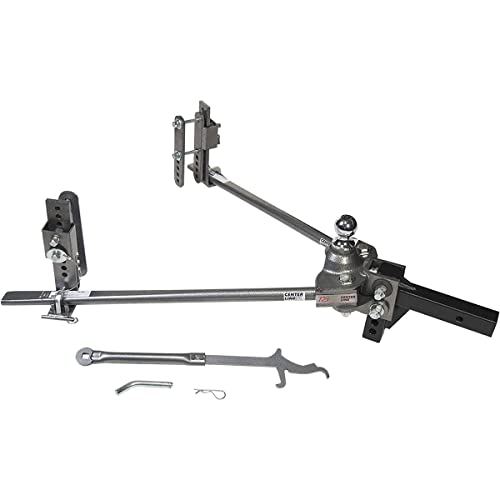
Possessing a heavy-duty body that consists of forged and hardened steel components, Husky 32218 is superior to ordinary weight distribution hitches in terms of ruggedness. In the course of operation, the hitch from Husky could withstand everything that people and the outdoors throw at it. Thus, for towing operations that involve both rough roads and challenging elements, 32218 is recognized as one of the leading options. Aside from that, Husky 32218 works in a quiet manner so noise is less than an issue and that is advantageous.
On arrival, 32218 comes with a preinstalled and torqued hitch ball that accelerates the setup process and eliminates the need to purchase the ball separately too. Moreover, owing to the incorporation of a handle, users would be able to engage and disengage the hitch of Husky in a couple of seconds. As a result, for those that lack the patience to hook up complicated hitches, Husky 32218 is the best anti-sway trailer hitch available for purchase. Being a breeze to clean and lubricate, 32218 requires minimal labor once it comes to maintenance.
With a GTWR of 12,000 pounds and a TW that stretches from 800 to 1,200 pounds, Husky 32218 could superbly support standard towing setups. The frame of the Husky hitch is also fully adjustable so its flexibility is outstanding.
- Intuitive handling
- Noise level is low
- A number of hitches arrive damaged
- Shank is slightly short

Loaded from top to bottom with innovative features and functions, Camco Eaz-Lift 48733 never fails to please people in use. By utilizing top-loading spring bars, Eaz-Lift 48733 provides extra ground clearance for towing setup which certainly helps a lot. Additionally, equipped with automatic sway control that engages and disengages on its own based on current condition, the Camco hitch is good at addressing swaying. Hence, Camco Eaz-Lift 48733 is the best sway control hitch for people that place handling above all while towing trailers.
As for capacity, the ratings of the hitch made by Camco seem unexceptional but they remain adequate: 10,000 pounds for GTWR and 1,000 pounds for TW. If you opt to pick up Camco Eaz-Lift 48733 then you could haul a wide range of loads with relative ease. Besides that, constructed using materials with admirable durability, Eaz-Lift 48733 would last a long time. Lastly, the hitch from Camco carries a handy powder-coating that resists corrosion so you don’t have to bother with rust on the road.
The installation of Camco Eaz-Lift 48733 is undemanding, therefore, setting it up is a cinch and there is no need to invest in additional hardware. When Eaz-Lift 48733 is installed properly, it operates without squeaking or squealing so its users should have no trouble focusing.
- Terrific lifespan
- Hitch mounts twist over time
- Several people report getting incomplete hitches

Your trailer is kind of heavy so you need a trailer hitch with sway bars that pack high weight ratings? Then it’s suggested that you take a look at SwayPro BXW1500 of Blue Ox. With GTWR of 15,000 pounds and a TW of 1,500 pounds, the weight distribution hitch from Blue Ox could accommodate substantial weights and maintain stability in environments. Also, with flexible spring bars that don’t have to be greased, SwayPro BXW1500 performs fluidly without needing dedicated maintenance.
With its head receiving adjustments before delivery, Blue Ox Sway Pro BXW1500 is ready-to-use as soon as it’s out of the packaging. Hence, during the installation of the Blue Ox hitch, there is no need to waste significant time on fine-tuning. It’s noteworthy that Pro BXW1500 happens to integrate quick latching that permits rapid hitch engagement and disengagement as well. Even when you have to back up your rig, it’s unnecessary to disconnect SwayPro BXW1500 of Blue Ox altogether.
In the course of operation, Blue Ox Pro BXW1500 seldom let out sounds which contribute to a low noise level. So with the hitch made by Blue Ox, you could give your ears a break as you maneuver your trailer
- Great ground clearance
- Magnificent capacity
- Resistance to elements is excellent
- Shipping needs to be overhauled
- Kind of cumbersome
Weight distribution hitches pack various features and functions but if you hope to get your money worth, it’s imperative that you remember these criteria
WEIGHT CAPACITY
Overall, different trailers come at different weights which is why you need to pay special attention to the weight capacity of your load distribution hitch . If you pair your towing setup with hitches that possesses inappropriate capacities then handling characteristics would worsen instead of improving. Normally, you could deduce the ideal weight capacity for your hitch by using GTW (Gross Trailer Weight) and TW (Tongue Weight) rating as guidelines. You should be able to locate those ratings in the owner’s manual of your trailer.
One more common question is whether a weight distribution hitch can be too big for your trailer. The answer is you can’t have ‘too much’ of a weight distribution hitch. However, the spring bars must be matched closely with the trailer for the system to work properly. Too weak and not enough weight is transferred to the front axle of the tow.
SWAY CONTROL
The last thing you want to experience while hauling heavy loads is to see your towing setup swaying uncontrollably in the midst of a turn. Because of that, as you search the market for the best weight distribution hitch , it’s strongly recommended that you take sway control into account. Nowadays, models utilize many methods to address swaying:
Some stop the sway as it unfolds: One prime example is the friction bar that attaches to the frame of trailers and weight distribution hitches. When the trailer moves out of the line, a downward force would be applied to the friction bar which limits further side-to-side movements.
One more thing to note is a weight distribution hitch system is either featuring dependent sway control or independent friction sway control. Each type deals with swaying differently.
With dependent sway control models, once the swaying starts, the spring bars will produce a downward force, which provides frictional resistance to the brackets located on your trailer frame’s sides. The friction comes from steel-on-steel resistance plus resistance from material that has the same consistency with brake pads.
Meanwhile, independent sway control models create friction through the use of a bar that bolts onto your trailer’s frame and is also attached to the hitch system, producing enough resistance to keep your trailer from swaying. This type of anti-sway system also features an interior bar that helps out by telescoping in and out to stop any bucking or binding of your trailer.
An independent anti-sway hitch system also features friction pads that will come into contact with each other you’re towing to produce extra resistance, further reducing any swaying.
Some models prevent it from happening in the first place: Some of the best weight distribution hitch with sway control integrate cams to secure spring bars, which will suspend and lock the spring bars into place. One end of a cam will attach onto the lift bracket via the lift chain and the other to your trailer’s frame. The spring bar’s rounded metal ends then sit inside the cams. This controlled location of the spring bars keeps the entire setup secure, so that your trailer will not sway from side to side.
Besides that, certain weight distribution hitches come with an innovative built-in 4-way sway control that rely on a stable connection in the head unit to get enough tension.
Meanwhile, the other two-points anti-sway systems work to provide resistance as well. These two points will work to ensure there’s enough tension produced throughout the hitch’s system, which will ensure swaying never becomes an issue.
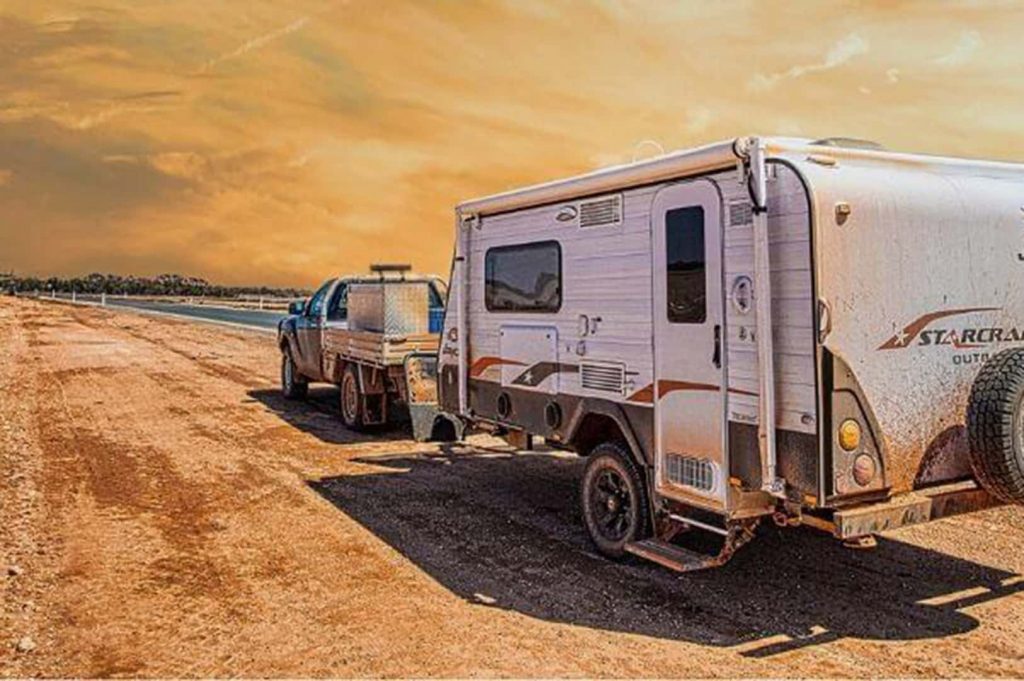
PRE-INSTALLED COMPONENTS
The time and stamina that go into the installation of weight distribution hitches tend to vary from model to model. That being said, models that arrive with pre-installed components usually don’t require much to get up and running. Hence, if you have a schedule to follow, it’s widely advised that you keep an eye out for hitches that come installed with components. To determine whether a particular model is delivered with pre-installed components, you should check out its owner’s manual.
INSTALLATION
You always have the option of hiring others and let them take care of the hitch installation in your stead. However, considering that you have already put aside money for a hitch, why don’t you grab one that you could set up on your own and cut unnecessary spendings? In most cases, you would get a general idea about the complexity of setup process of a weight distribution hitch via the owner’s manual. For good measure, it’s suggested that you read several customer reviews and see what people say about the setup process of models you like.
DURABILITY
In the course of operation, weight distribution hitches must constantly manage substantial weights and deal with plenty of outdoor elements. That is why as you assess models on the market, you have to keep durability in mind at all times. If you hit the road with a flimsy hitch that is prone to fail, not only you need to spend money on replacements but you also risk your well-being. By inspecting the construction material, it’s a breeze to see how well models hold up as time passes by.
- Below $500 : With the ability to take on the average towing loads, weight distribution hitches in the price range work superbly in an assortment of operations. In addition, models that cost less than $500 have excellent compatibility so it’s simple to pair them with standard setups.
- Above $500 : Intentionally optimized for demanding operations, weight distribution hitches in the price range could withstand significant weights and unforgiving elements. While dropping more than $500 on a weight distribution hitch may seem excessive, you could save money in the long run thanks to lengthened replacement intervals.
Today’s weight distribution hitches come from a wide range brands but in terms of reputability, a couple of names stand out from the rest
With decades of experience in designing towing hitches and associated accessories, Camco knows exactly what people face on the road. In the case that you seek a no-nonsense anti-sway hitch that could even out the trailer weight, you should prioritize models from Camco.
Known for assembling hitches that rely on chains and dampers instead of sway bars, Andersen is held in high esteem by a lot of people. Once it comes to adaptability, Andersen hitches don’t have many competitors on the market.
Equal-i-zer
Owing to the user-oriented approach, Equal-i-zer is capable of releasing solid hitches that rarely let people down. In addition to that, reaching the market at reasonable prices, models made by Equal-i-zer match multiple shopping budgets.
By emphasizing utility, Blue Ox and its weight distribution hitches receive a shower of praise from those who have to routinely haul heavy loads. It’s noteworthy that Blue Ox models arrive with virtually everything too so they don’t take long to set up.
FAQs About Weight Distribution Hitches
Weight distribution hitches do not reduce tongue weight or in other words, allow you to tow beyond the capacities of the vehicle. What these systems do is distribute the tongue weight of a trailer up to the front axle of the tow vehicle so that it will sit more level and thus handle and brake better.
No. As weight distribution hitches do not reduce tongue weight, in other words, these systems won’t allow you to tow beyond the capacities of the tow vehicle. If your hitch is rated for use with weight distribution, the weight distribution system will allow you to tow at the maximum capacity of the hitch. Weight distribution doesn’t “increase” your hitch’s capacity so much as it allows the hitch to be used at its maximum capacity.
A weight distribution system typically offers even weight distribution: it redistributes about 1/3 of the tongue weight onto the trailer axles, 1/3 of the tongue weight onto the tow vehicle’s rear axle, and the remaining 1/3 onto the tow vehicle’s front axle.
Every truck of any size requires a weight-distributing hitch when using a bumper trailer hitch ball. Using a weight distribution hitch becomes more necessary as your trailer weight gets closer to your tow vehicle weight, and is a must if your gross trailer weight when fully loaded is more than 50% of your tow vehicle gross weight. In addition to a weight distribution system, trailer brakes are also recommended in these cases. As a rule of thumb for safety, most mid-size and half-ton trucks require it when gross trailer weight exceeds 5,000 pounds, while heavy-duty trucks will require a weight distribution system when trailer weight exceeds 6,000 pounds. The limit for the most heavy-duty trucks might be around 8,500 pounds.
Not every weight distribution hitches can be used with surge brakes. This is because most chain-style systems are not compatible with surge brakes as they do not allow for enough back and forth movement of the trailer to activate the actuator. Only specified systems rated as surge brake compatible can be used with surge brakes. One note is even if a chain-style weight distribution system is rated as surge brake compatible, adding friction sway control bars to these systems will make the system incompatible with surge brakes. To make sure your brakes operate at maximum effectiveness and are not prevented from compressing, you must not use a chain/snap-up bracket system with your surge brakes.
1. Adjust tongue weight Not enough tongue weight is the most common cause for trailer sway. The tongue weight must be 10 to 12 percent of the trailer’s weight for the most balanced and level drive. For example, if the gross weight of your trailer is 2,500 pounds, the tongue weight on the hitch should be about 250 pounds. As a quick fix before you can buy the best weight distribution hitch for your trailer, you can try to redistribute the weight as necessary by removing some items, place heavier cargo at the front of the trailer, center the cargo left-to-right, and use reinforcements to firmly secure the cargo to prevent them from moving around. 2. Proper tyres inflation In addition to getting the best weight distribution hitch that you can afford, the very first thing you should do is ensure that the tyres of both your tow vehicle and your trailer are properly inflated. Underinflation is a common culprit for unlevel and unbalanced drive, while overinflation might make the ride more bumpy. 3. Install a friction sway control device The most ideal course of action is to get a best weight distribution anti sway hitch. Otherwise, you can get a friction sway control device designed for use in trailers that have a low tongue weight percentage. For trailers that are over 5,000 pounds, sway control devices should be attached to both sides of the trailer hitch. These friction sway control devices reduce the effects of sudden gusts of strong wind and sharp turning by applying resistance to the trailer and vehicle with respect to each other. When driving, stop and turn the adjustment handle a quarter of a turn in the clockwise direction, which adds more friction. Continue to do this until your trailer feels straight and stable. 4. Sway control bar Most weight distribution hitches allow the trailer to be backed into place without having to be taken off. But when you’re backing into tight turns, you might experience swaying because of the sway control bar. If you have a sway control bar, it’s recommended to disengage it before reversing or tight maneuvering. 5. Do not overload your trailer Keep in mind that your load capacity includes the weight of the trailer, tongue, vehicle, and your passengers. 6. Avoid windy conditions If you can’t, here are some tips for safe driving with minimal swaying in these conditions: Steady the steering wheel at all times: do not make sudden turns, and do not try to steer out of a sway situation. Never slam on the brakes when you’re experiencing trailer sway but gradually and steadily reduce speed instead. Try to keep the speed at a moderate level whenever you’re not on the highway, since higher speeds make trailer sway more severe. Apply only the trailer brakes to help reduce sway. If the problem persists, it’s safest to pull over to evaluate the cause of the sway. Whether or not you can pinpoint the culprit right away, it’s best to head to the nearest repair shop to have the problem looked at.
Weight distribution hitches that pay special attention to sway control usually shout it in their name, like the Fastway E2 2-point Sway Control that’s famous for its 2-point sway control feature. This model indeed receives raving reviews from buyers and is one of the best sway control hitch products on the market, but remember that you must browse through the reviews to see if the product really delivers what it’s advertised to do. There are also models with advertised adjustable sway control, like the Camco Chem 48751 ReCurve R3 Weight Distribution Hitch Kit , also a favourite among campers. What RVers love about this product is that it delivers an unprecedented amount of sway control placed on your trailer by adjusting the clam, and you can turn this feature off or on whenever it fits your situation.
Also in RV Hitch & Tow , we’re providing thorough reviews and buying guides which help RV campers have peace of minds choosing the best fifth wheel hitches for short bed trucks , best removable fifth wheel hitches , best anti-rattle hitch devices , best trailer hitch locks , best electric tongue jacks , best tow dollies on the market today.
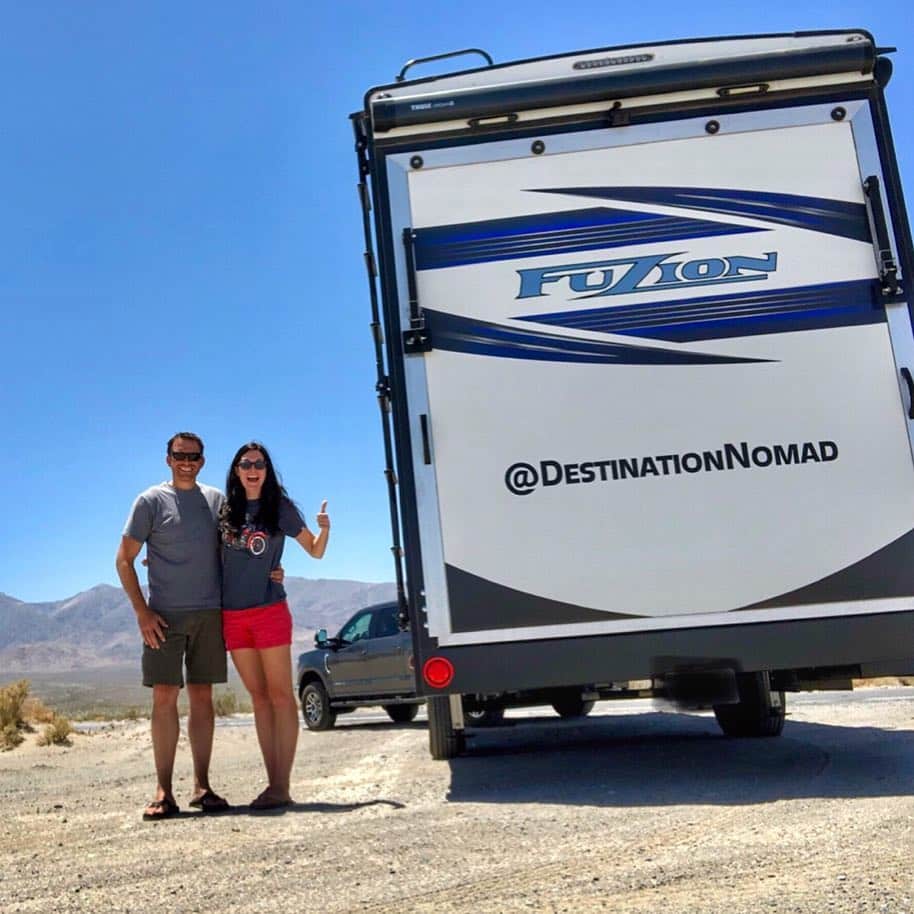
About Chris Coleman
Chris Coleman is an interesting travel blogger and outdoor photographer with a great sense of humor. He owns an RV Accessories shop in New York City so he has the knowledge necessary to provide thorough reviews and give advice on how to choose the right products for RV travel. He puts all that RV knowledge and experience to good use in his sharing posts. Besides product buying guides/reviews, Chris also writes informative articles, how-to articles and RV camping guides in his own interesting viewpoint. Chris’s blog is one of the most reliable information sources for RV campers no matter if you're an expert or a determined beginner.
Related Articles in this Category
6 types of fifth wheel hitches, when to use them and which ones to buy, best 5th wheel to gooseneck adapters: an in-depth review, the 6 best removable fifth wheel hitches to buy in 2022, the 12 best anti-rattle hitch devices to buy in 2022, the 5 best rv tow dollies to buy in 2022, the 12 best electric tongue jacks to buy in 2022, the 7 best trucks for towing 5th wheel trailers, the 12 best trailer hitch locks (review) in 2022, gas vs diesel for towing a fifth wheel: which one is better, how does weight distribution hitch work, how to increase towing capacity on a vehicle, trailer hitch installation cost: the ultimate guide, the 12 best fifth wheel hitches for short bed trucks, gooseneck vs. 5th wheel hitch: what’s the difference, 1 thought on “the 12 best weight distribution hitches to buy in 2022”.
Dear Mr. Coleman:
I am curious as to why the Hensley Arrow Towing System (which eliminates sway when towing) did not make your list of the best weight distribution hitches. Perhaps because it is not a traditional weight distribution hitch but in a separate towing system category.
FYI — We towed our 29′ K-Z Sportsmen travel trailer (with fiberglass exterior and a slide out) for many years throughout the western US and across country (from Virginia to Utah) and experienced absolutely no sway when towing with our 12 Passenger Ford Econoline Van (V-10 engine).
Leave a Comment Cancel reply
Save my name, email, and website in this browser for the next time I comment.
- See All Reviews

Fastway e2® Weight Distribution Hitch
For the best and safest towing experience, you need the e2® hitch, providing you with faster and easier weight distribution and sway control.
The e2® hitch gives you faster and easier sway control and weight distribution without the hassle of chains or add-on sway bars. With its built-in sway control, the e2 hitch has no backing, turning, or weather restrictions - when you need sway control the most. Its rigid brackets give you permanent sway control for smarter, safer towing. For the best hitch setup and safest tow, we recommend you purchase from our dealers . We have strong partnerships with our skilled and knowledgeable dealers, who can help you choose the best hitch for your truck and trailer. After identifying the hitch, they can properly install the hitch on your trailer, and provide in-person education on hitching, unhitching, and maintenance.
If there isn't a dealer near you, we are happy to assist. Please contact our customer service team if you have questions before you purchase.
- Starting At $ 555.0
- Preorder Now

CONFIRM PREORDER
The Fastway e2® weight distribution hitch offers faster and easier sway control and weight distribution. With built-in, permanent sway control, you can hitch up, tow, and unhitch with ease. There is nothing extra to connect or store, and nothing to remove when backing or making a tight turn.
The e2's rigid brackets provide two points of steel-on-steel friction, constantly working to fight sway. Its unique design provides a level ride while minimizing sway caused by winds, semi trailers and sudden maneuvers. The e2 hitch comes in round-bar and trunnion styles. Both offer fast and easy sway control and weight distribution. The e2's smart design can be installed around gas tanks and battery boxes, works with surge brakes, and can accommodate any trailer type.
Helpful Resources for the Fastway e2® Weight Distribution Hitch
How to install the e2® Hitch
e2® Round Bar Hitch Owners Manual
e2® Trunnion Bar Owners Manual
e2® Hitch Replacement Parts
Specifications
The Fastway® e2™ Weight Distribution Hitch comes in round bar and trunnion styles. Both offer fast and easy built-in sway control and weight distribution. If ground clearance is a consideration in your setup, one of the e2 trunnion hitches will work great for you. Below are the hitches we offer in both the round bar and trunnion styles:
*Includes 2 5/16″ hitch ball installed
Trunnion Style Hitches
Round bar style hitches, customer reviews.
Bought your 10,000 lb weight distribution hitch for our 35' long, 6,800 lb travel trailer. Towed it about 30 miles on 4/13/18 from storage to our house in winds gusting up to 50 mph. It performed perfectly. The next day was a 2.5 hour pull to our campground NE of Columbus, Ohio. I couldn't not believe how effortless the pull was. At times I was literally able to have one hand on the steering wheel if needed. Thanks for this great product!
- Written By: Don R.
- Apr. 16, 2018
Installed the e2 6,000 lb trunnion hitch for an 18 ft travel trailer. Pulling it with a 2015 Tacoma V6. Works great! Got the setup right on the first try. Instructions were very good. Happy with the product.
- Written By: Dave L.
- Feb. 27, 2018
Absolutely love the product. Towed my 25 ft toy hauler across the country and all over the south with it. No problems and it makes a great towing experience!
- Written By: Cindy
- Sep. 06, 2017
Our friends recommended that we get the e2 trunnion hitch for our 26 ft Jayco mated to our F150. Everything has been great. It is easy to hook up and disconnect, and when pulling, the trailer is stable and we have no swaying of any kind.
- Written By: Perry and Kathy
- Apr. 03, 2018
Love my weight distribution hitch. Does everything I expect of it. Easy on and easy off. No chains to remove when backing up.
- Written By: Jack H.
- Oct. 12, 2017
I've been getting peace of mind and safety using my Fastway e2 hitch for a few years. Now I've had to use their Customer Service. I got fast, intelligent answers, good news, and quick service. Got to be one of the best customer service departments I've ever dealt with. Thank you, Fastway.
- Written By: Carol B.
- Dec. 10, 2016
No more chains and sway bars. Love it. Easy on and off. Good quality too. Install was easy. Awesome product.
- Written By: Kris Y.
- Apr. 07, 2018
Since we got our trailer over 1.5 years ago, we used e2 weight distribution system and I'm so satisfied and happy about it. Fastway is the Rightway!
- Written By: Obeng O.
- Aug. 18, 2017
Can't tell you how much I trust your hitch. Even the 8,000 lb hitch has the truck and trailer level. If I ever get a heavier rig, I will most certainly buy another hitch from you guys. Again, thank you.
- Written By: Chris G.
- Apr. 13, 2017
Hello, just wanted to say I love my trunnion e2 hitch. First time towing a travel trailer, and the hitch has helped boost my confidence.
- Written By: Eric B.
- Jun. 08, 2017
We have been using your weight distribution hitch for our 31 ft. Komfort trailer for 10 years now... Never a worry or an issue this entire time. We feel very safe in our 37 states we have visited so far.
- Written By: Roger S.
- Jan. 30, 2018

IMAGES
VIDEO
COMMENTS
The weight distribution hitch helps distribute the weight of the trailer evenly across the vehicle and trailer axles, improving handling and stability. As a result, you can back up with confidence and enjoy a smoother and safer towing experience. If you're planning on towing a trailer, RV camper van, or any other load, having a weight ...
Ball and Shank. Next, you'll need to pick the right ball and shank that match your weight distribution system. Hitch balls are rated 2,000 to 30,000lbs and you should never go with one that's rated below your weight distribution system. You'll also need to pick the right size. The most common hitch ball sizes are 1-13/16", 1-7/8", 2 ...
Slowly lower the saddle and remove the chain connecting the bar to the trailer. Move the bar sideways away from the trailer until it releases from the towing vehicle. Repeat these steps on the opposite side so that both bars are loose from the weight distribution hitch. As you can see, backing up with a restricted weight distribution hitch is ...
6,330. Yes, it is recommended to remove friction type devices before backing up. I don't know about the E2. I use a Reese Dual Cam, and don't have to remove the bars before backing, and most others don't either if properly set up. I think I would have issues with other things before I would have issues with the hitch.
Expert Reply: Some weight distribution system prohibit reversing because doing so could damage the system. If you are backing up in a straight line though it would be fine. But to make turns while backing up you would need to disengage the spring bars and/or the friction sway control unit, like on # PS49582, and then maneuver the trailer.
Step 3: Install the Hitch Ball. Slide the hitch ball into the head assembly and secure with a washer and nut. In its final position, the top of the hitch ball should be about 1/8th" higher than the coupler for every 100 lbs of tongue weight. For instance, if you have 800 lbs of TW, your ball should be about 1" heigher than the coupler height.
Load Heavier Items Forward. Place heavier items toward the front of the RV (but not too far forward) to achieve a proper tongue weight, which is typically recommended to be between 10-15% of the RV's total weight. An incorrect tongue weight can lead to swaying and loss of control. 5. Use a Weight Distribution Hitch.
This comprehensive guide covers the benefits of weight distribution hitches, sway control, 2-point vs. 4-point systems, and how to install a weight distribution hitch correctly. ... (RVs) for camping, road trips, or extended travel. They often tow large travel trailers and they use weight distribution hitches to ensure safe and stable towing ...
Now, lower the tongue weight of the trailer onto the hitch and latch the coupler. Don't connect your weight distribution hitch yet, but go back and take a new measurement at the same spot on your tow vehicle. Your second measurement should be higher as the weight of your trailer takes some of the weight off your tow vehicle's front axle.
Insert the hitch pin and secure it with the clip. Grease the hitch ball. Raise the tongue of the trailer higher than the hitch ball. Release the parking brake and back the tow vehicle up so that the hitch ball is directly under the coupler. Set the parking brake again. Lower the trailer coupler onto the hitch ball.
Step 2: Attach the WD shank and hitch head. Insert the weight distribution shank into the receiver tube. Be sure that the shank is fully inserted in the receiver tube of your trailer hitch and secure it using a hitch pin & clip. Position the head assembly on the adjustable shank. The head should be raised into position so that the top of the ...
In this RV how to video for RV newbies, Mark Polk with RV Education 101 demonstrates how to hitch and unhitch a travel trailer using a weight distribution hi...
Connect the trailer coupler to the hitch ball and secure the coupler latch. Install the spring bars and brackets according to the hitch type (trunnion bars or round bars). Adjust the spring bar tension as per the manufacturer's recommendations. Connect any additional sway control devices, if applicable.
Spring bars come in round, trunnion, and square shapes. Check out our article, Confidently Choose Your Weight Distribution Hitch - Here's 5 Tips , for help on choosing between them. 5. Frame Brackets. Frame brackets mount to the frame of your trailer and are used to hold the spring bars in place.
In this video, we'll take a hands-on approach to the topic of towing an RV using a weight distribution hitch and demonstrate what a weight distribution hitch...
Yes, the Equal-i-zer hitch is designed to allow you to back up and take tight turns with the hitch hooked up. Just be sure the frame brackets are installed in the correct range on the trailer frame (27"-32" from the center of your coupler) so the arms have plenty of room (2"-3" after the bracket) to move during tight turns.
Class 3: Also known as Heavy Duty, Class 3 hitches can handle up to 8,000 pounds gross trailer weight and up to 800 pounds tongue weight. These are typically found on crossovers, minivans, SUVs ...
Boat Steering Systems. This step-by-step guide is meant to show you just how easy setting up a weight distribution hitch can be. We'll walk through the general principles of how to set up a WD hitch so you can feel confiden.
This hitch excels in providing superior sway control and weight distribution, ensuring your trailer remains steady in various driving conditions. Based on my experience, the top stabilizer hitches for travel trailers are: Blue Ox BXW1000 SWAYPRO Weight Distributing Hitch: Best overall for its exceptional sway control and weight distribution.
As a result, those who desire well-rounded weight distribution hitches consider Pro Series 49913 of Reese as the best weight distribution hitch for travel trailer. Since the Reese hitch is a preinstalled model that arrives with hardware already attached, its setup process is pretty short. The inclusion of an ergonomic integrated handle greatly ...
Weight distribution system capacity ranges from 100 lbs to over 2,000 lbs. To choose the right weight distribution hitch size, you'll need to determine your trailer tongue weight and the weight of any cargo behind the rear axle. That number will be the tongue weight your weight distribution hitch will need to support.
This is an instructional video of how to properly disconnect your trailer from the truck when using your weight distribution hitch.
The e2® hitch gives you faster and easier sway control and weight distribution without the hassle of chains or add-on sway bars. With its built-in sway control, the e2 hitch has no backing, turning, or weather restrictions - when you need sway control the most. Its rigid brackets give you permanent sway control for smarter, safer towing.
A weight-distribution hitch uses spring bars to help level the load a trailer places on your tow vehicle and reduce sway. This type of hitch is often the most cost-effective way of improving ...